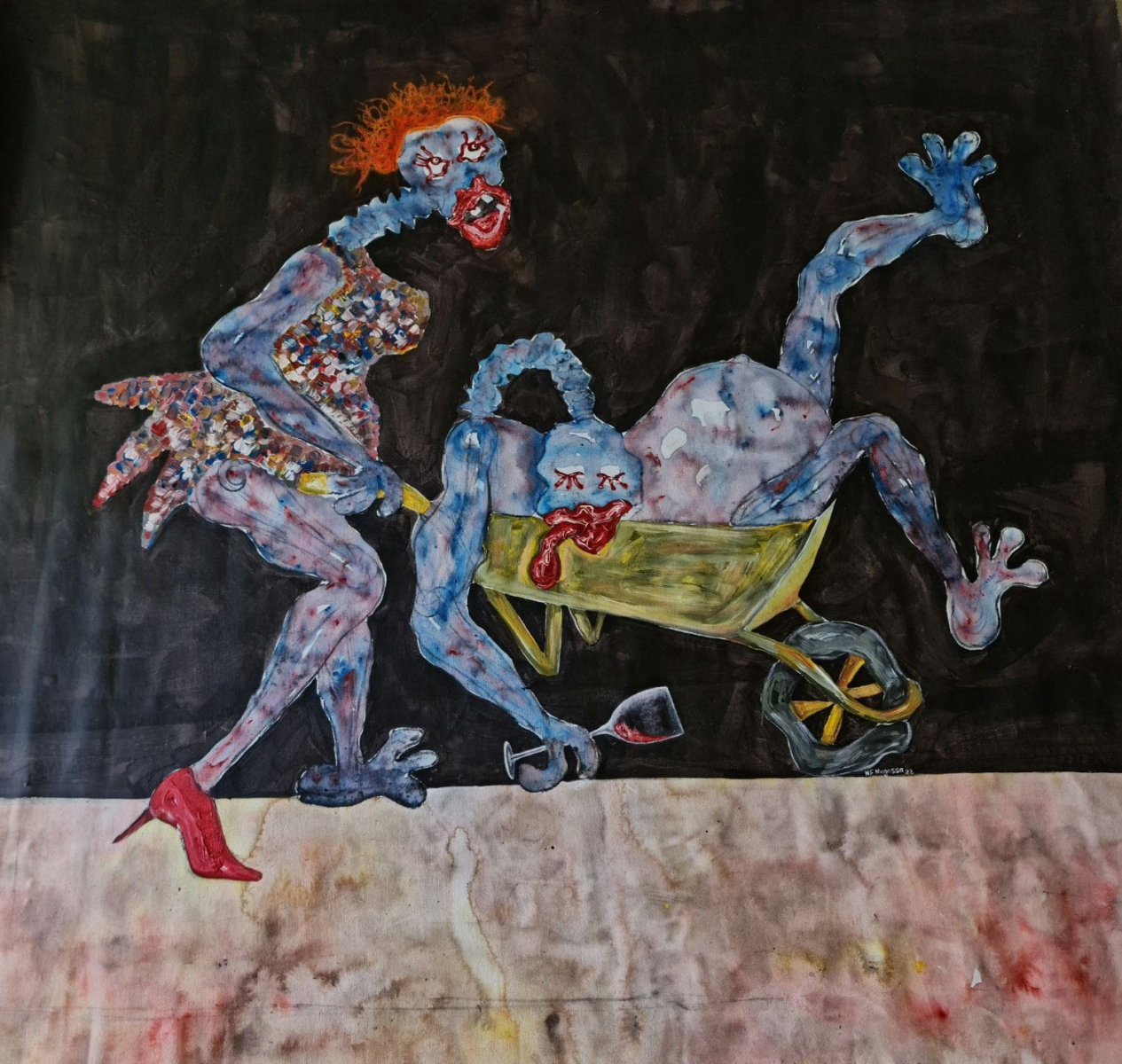
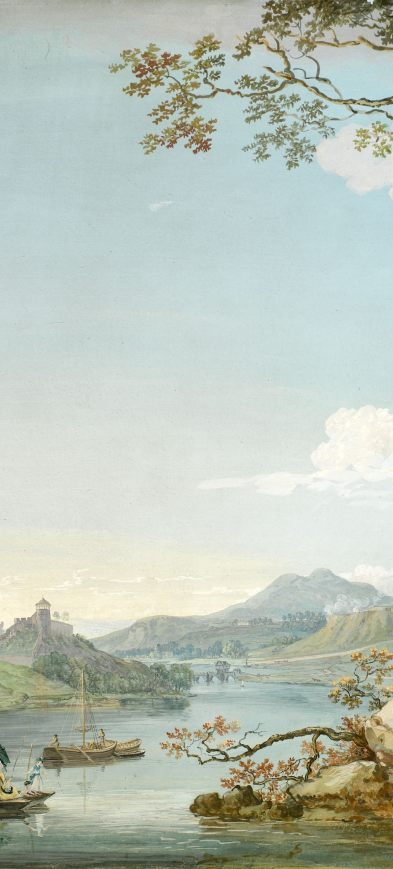
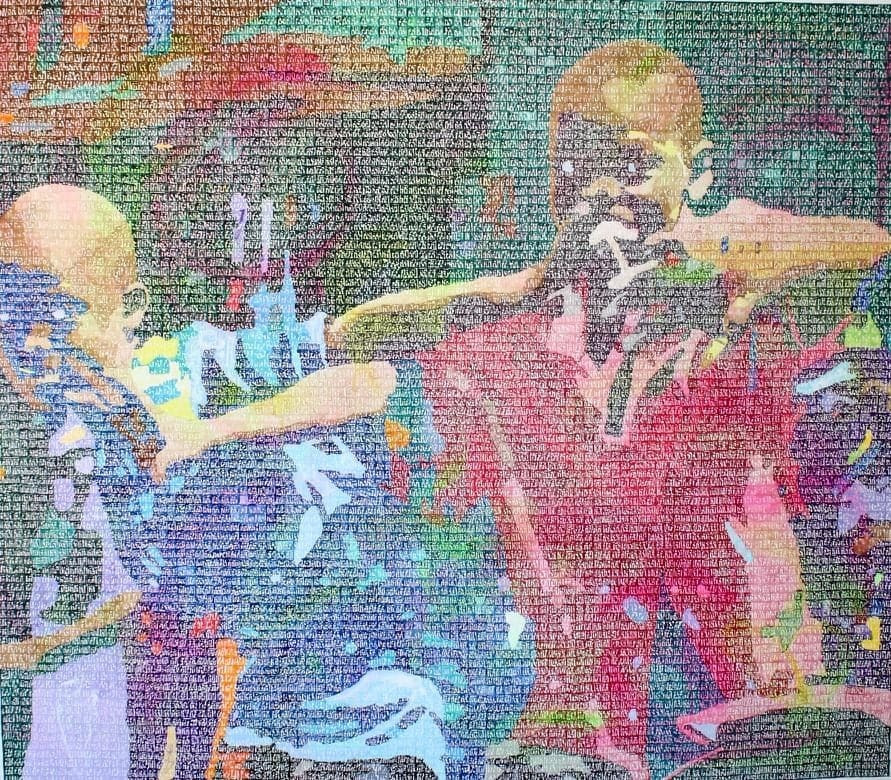
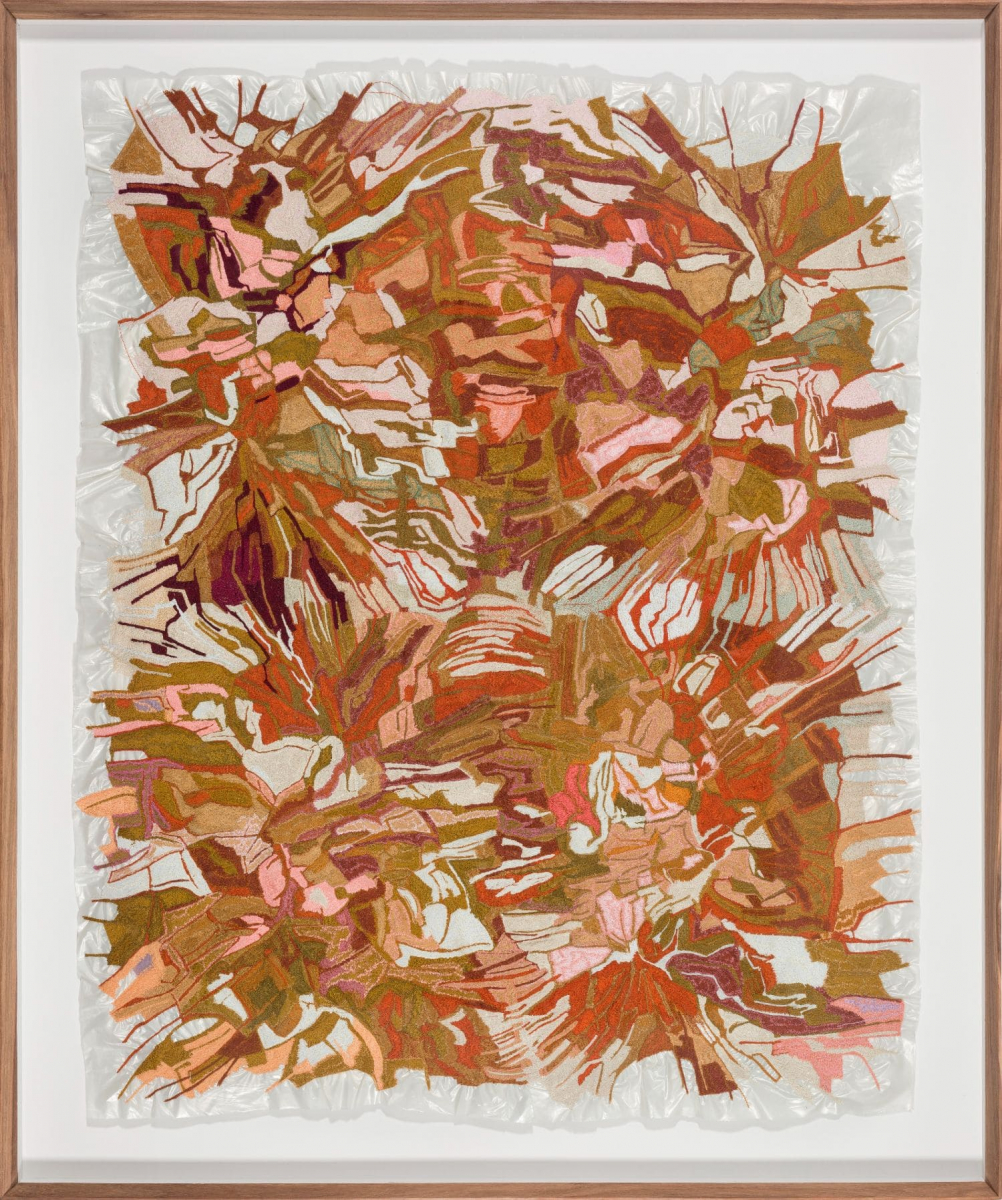
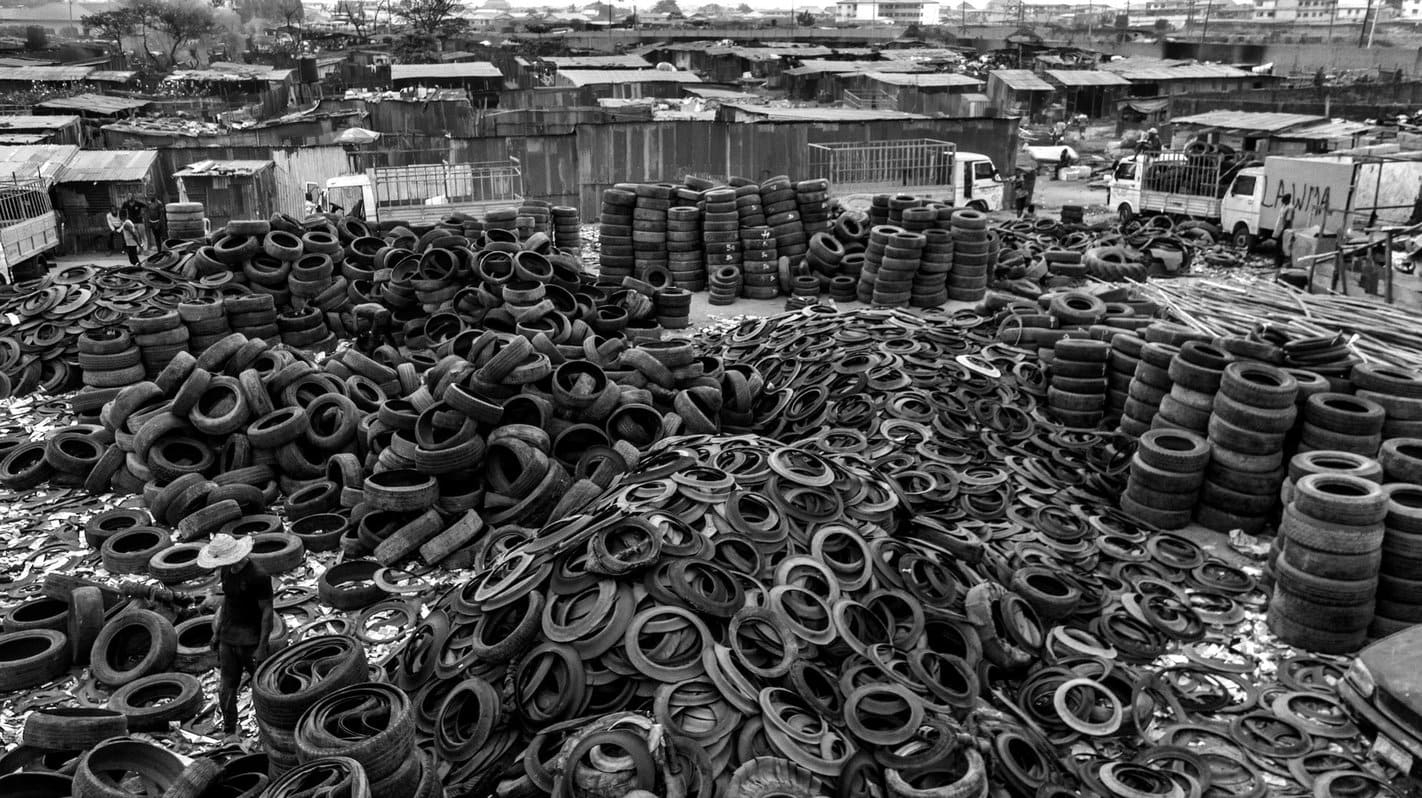
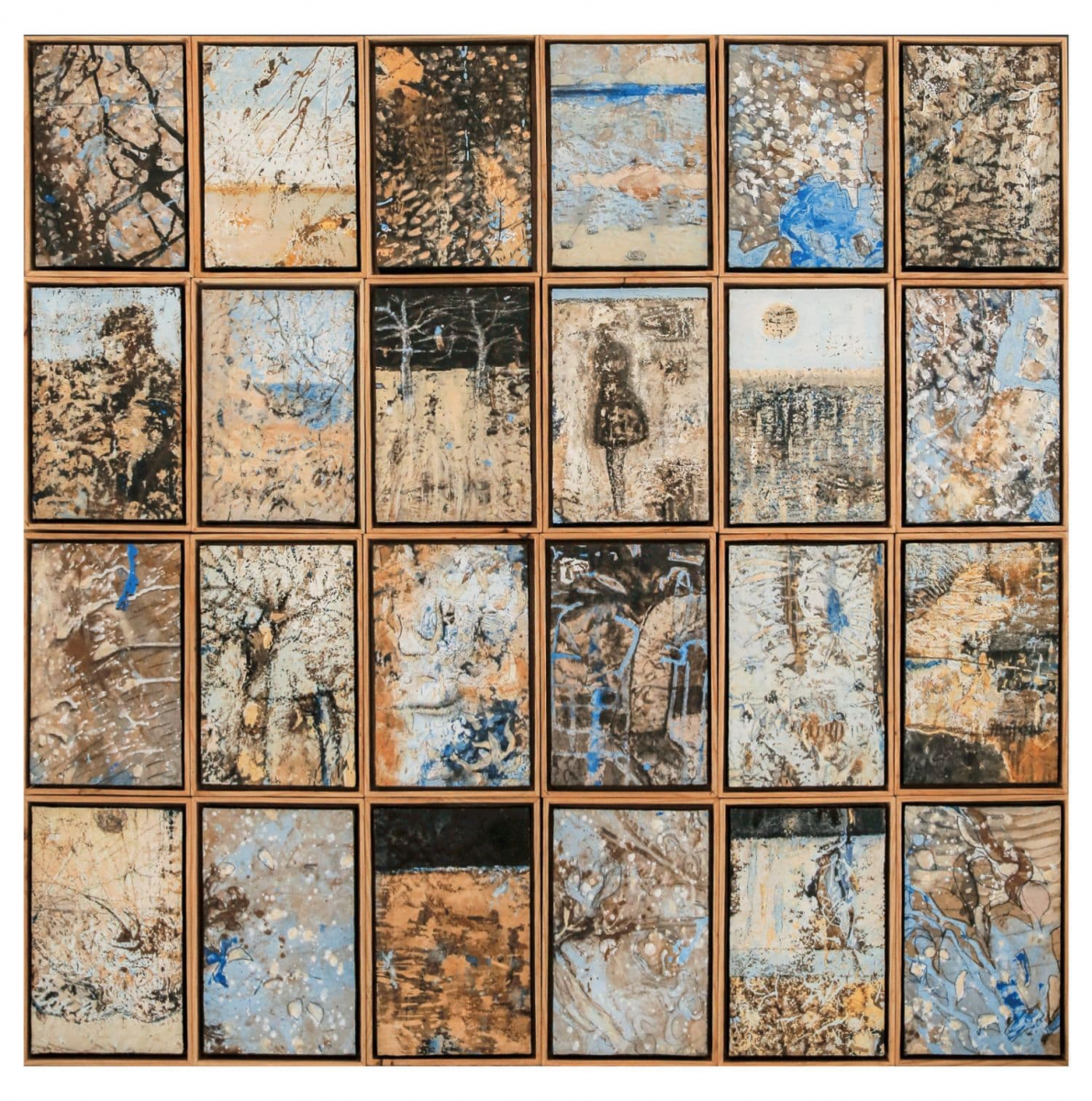
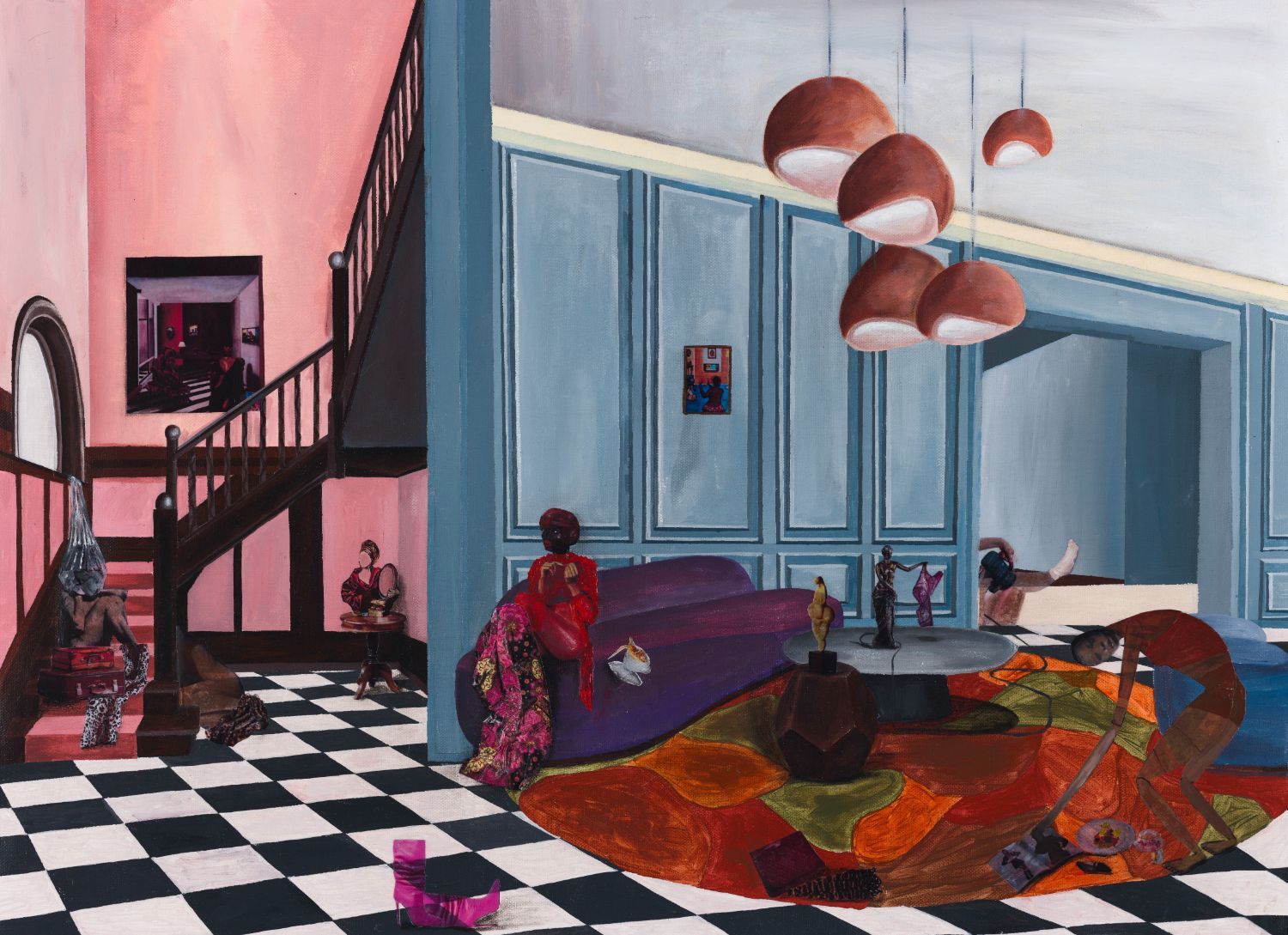
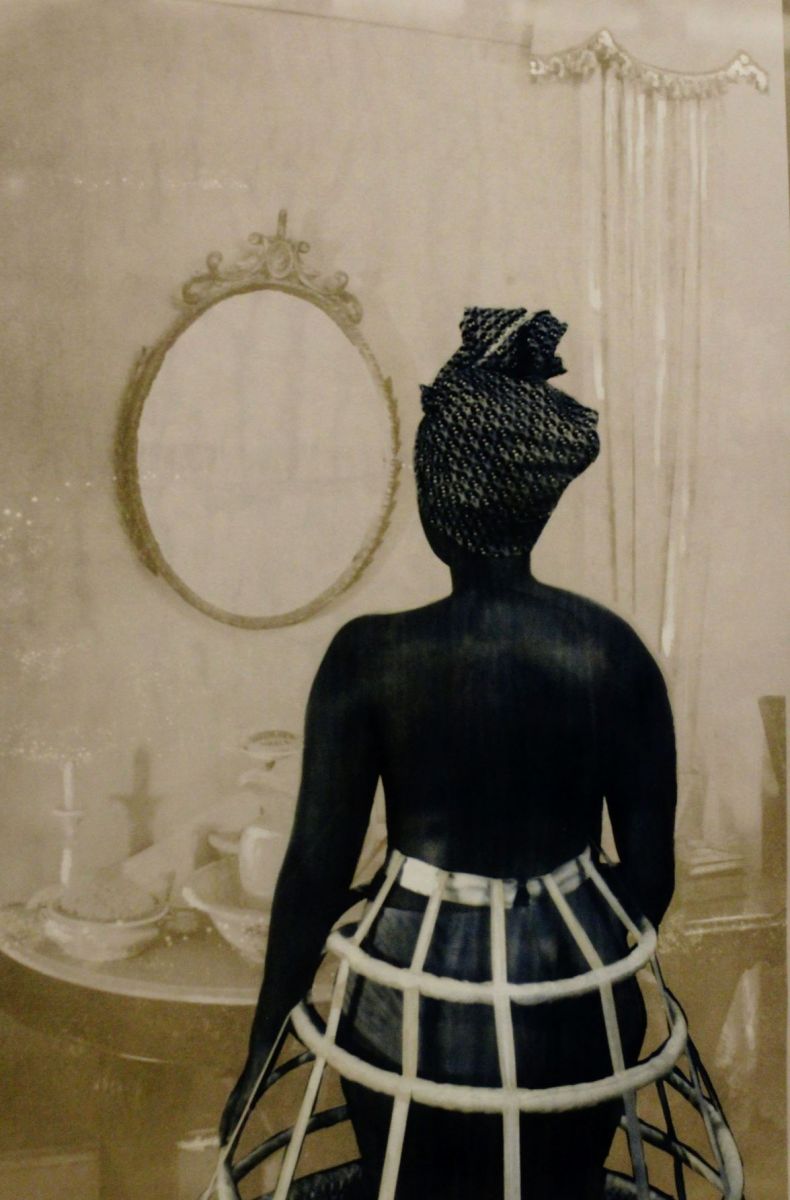
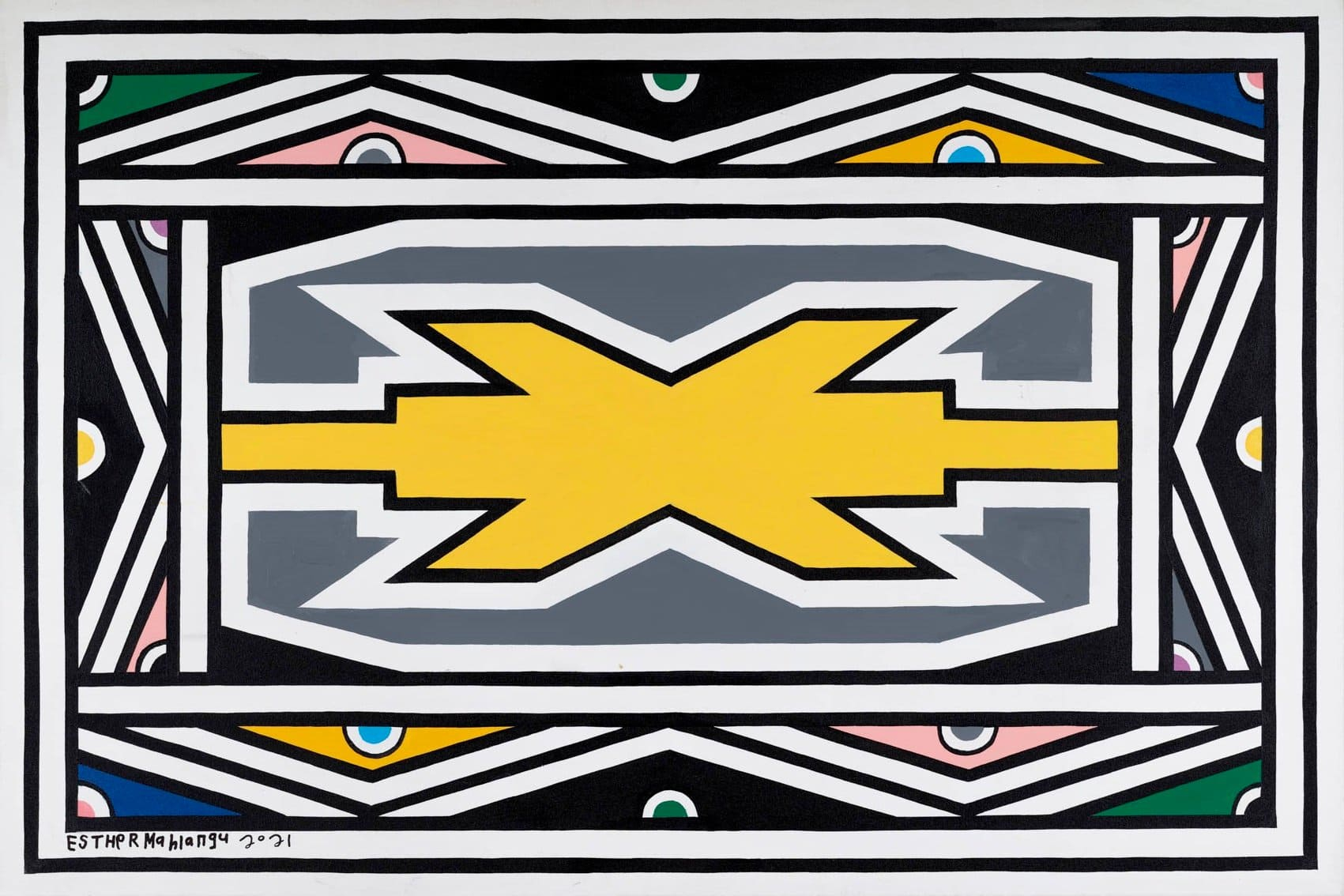

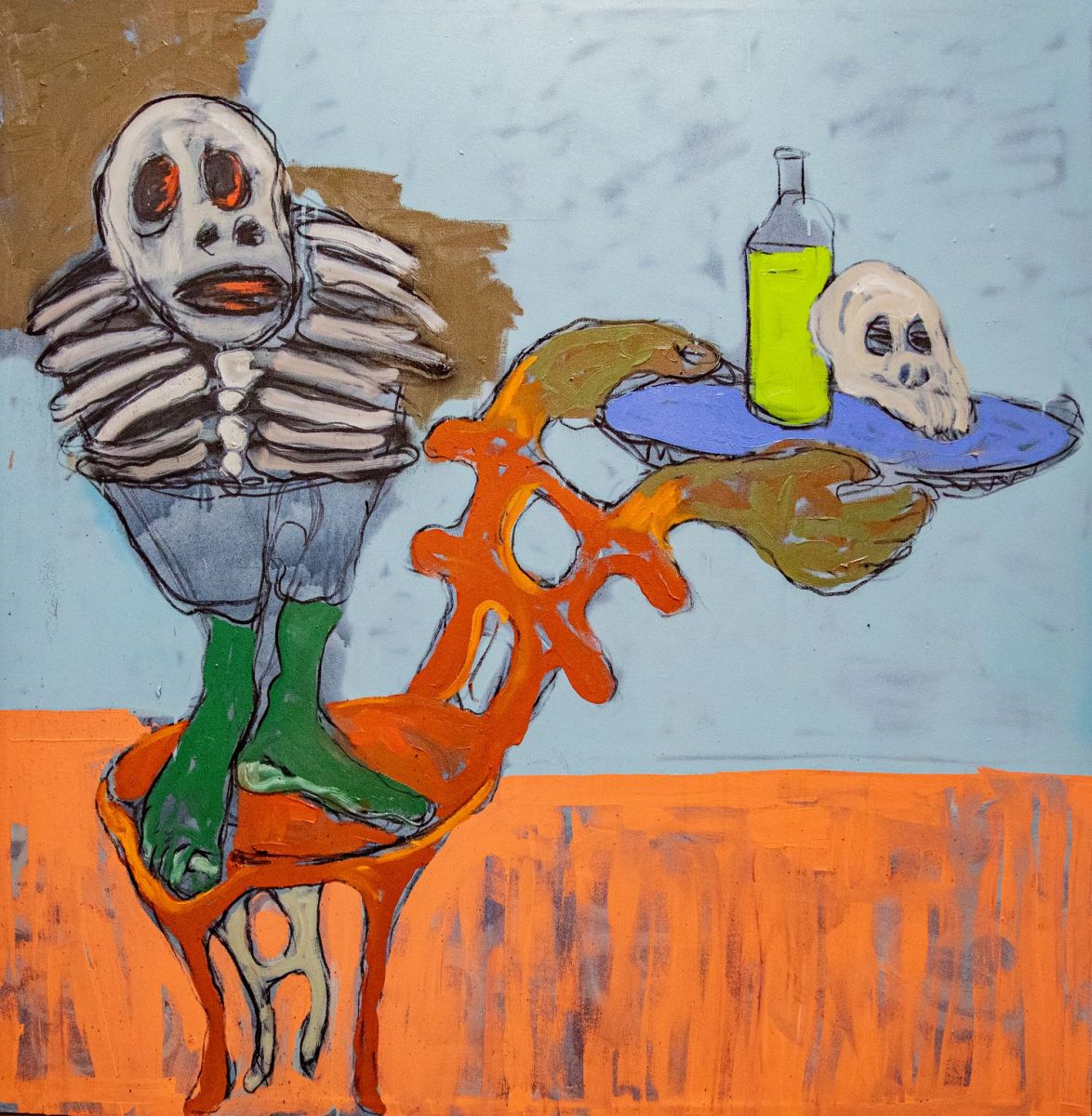
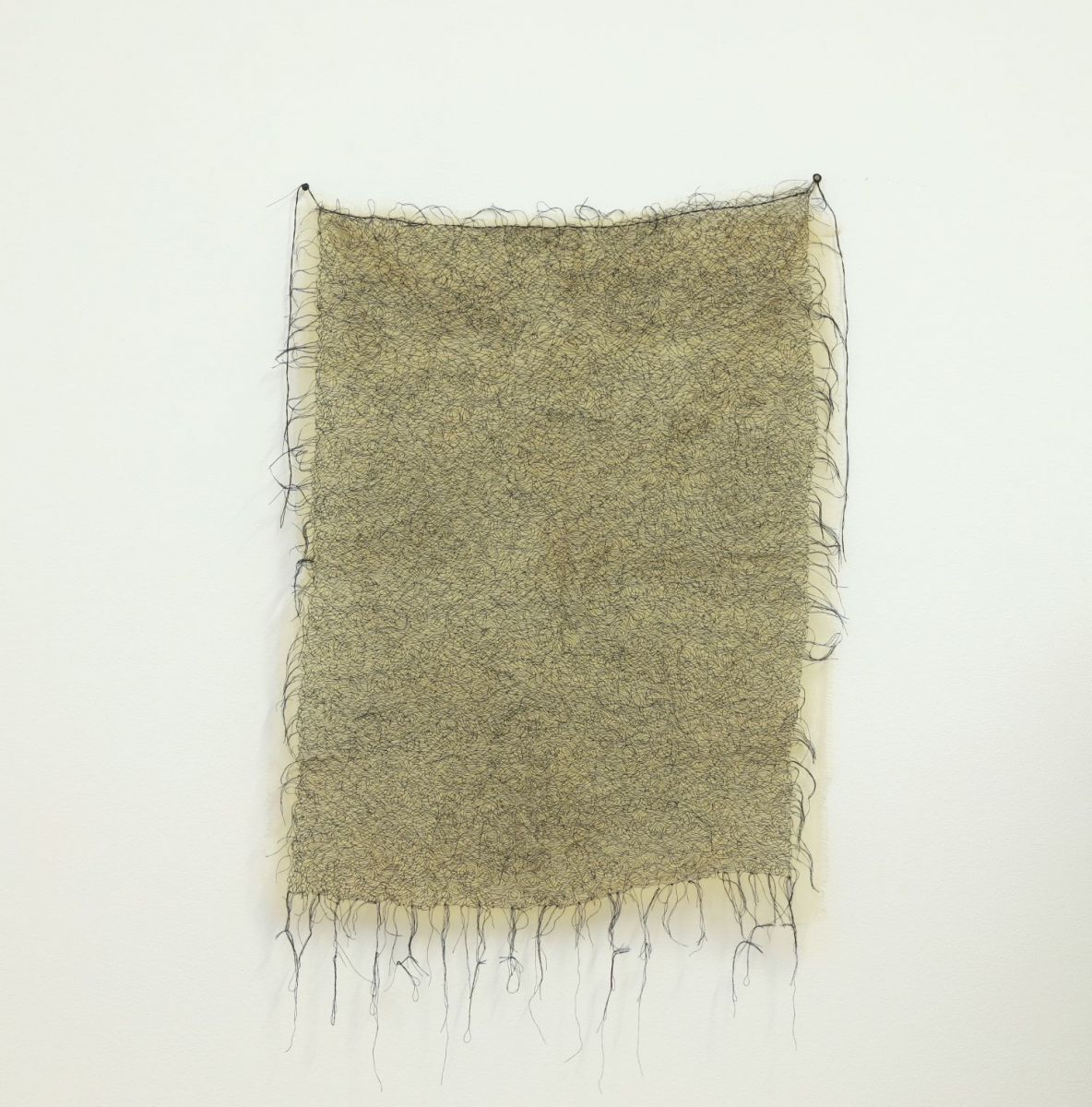
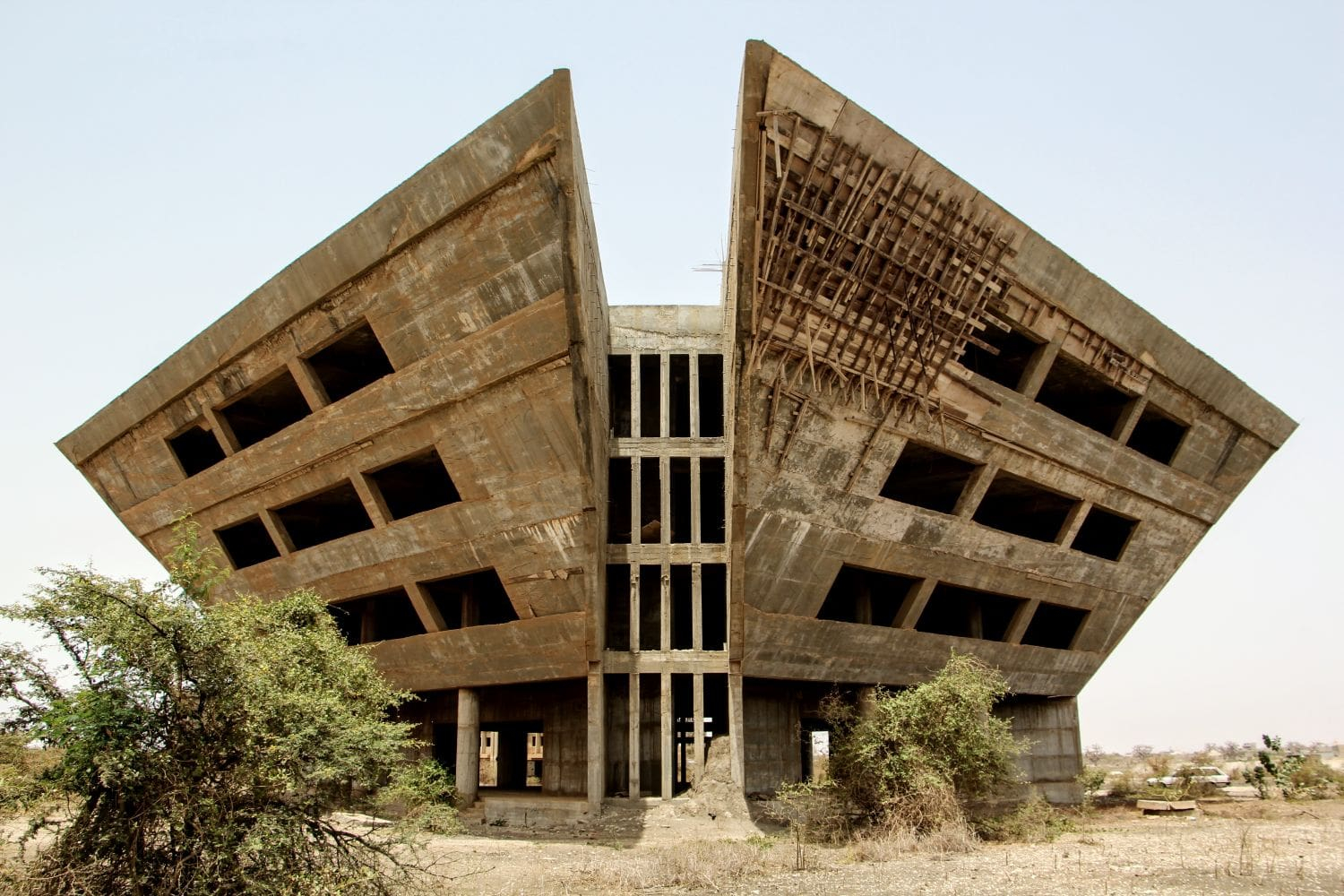
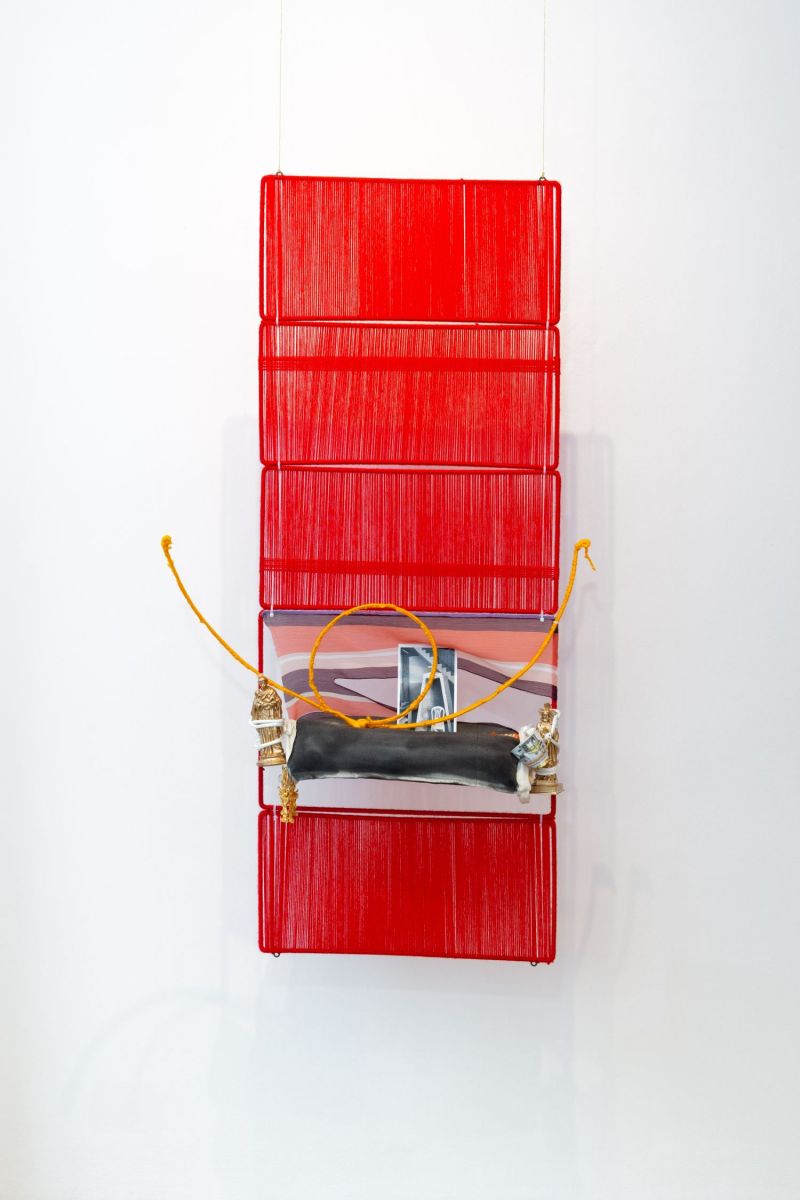
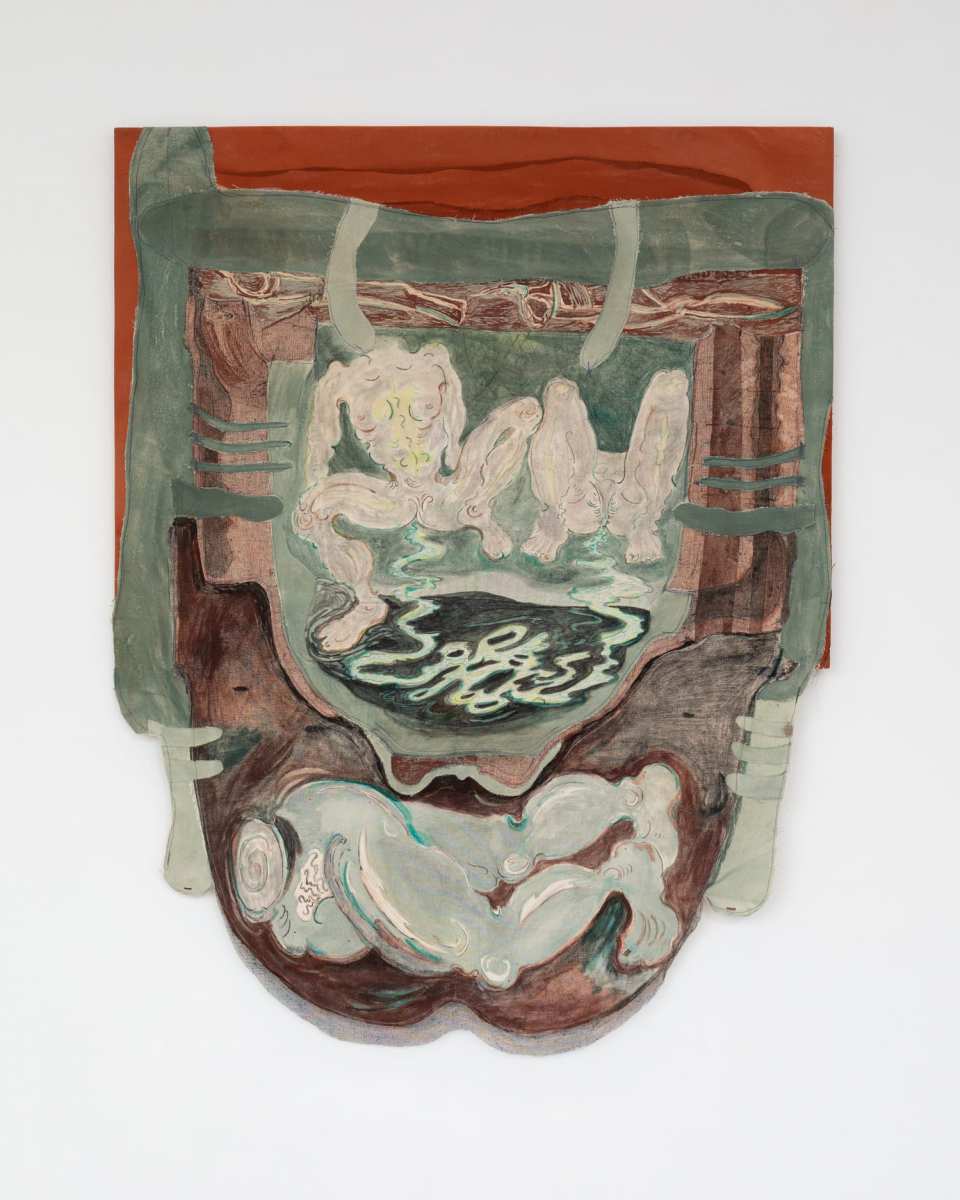
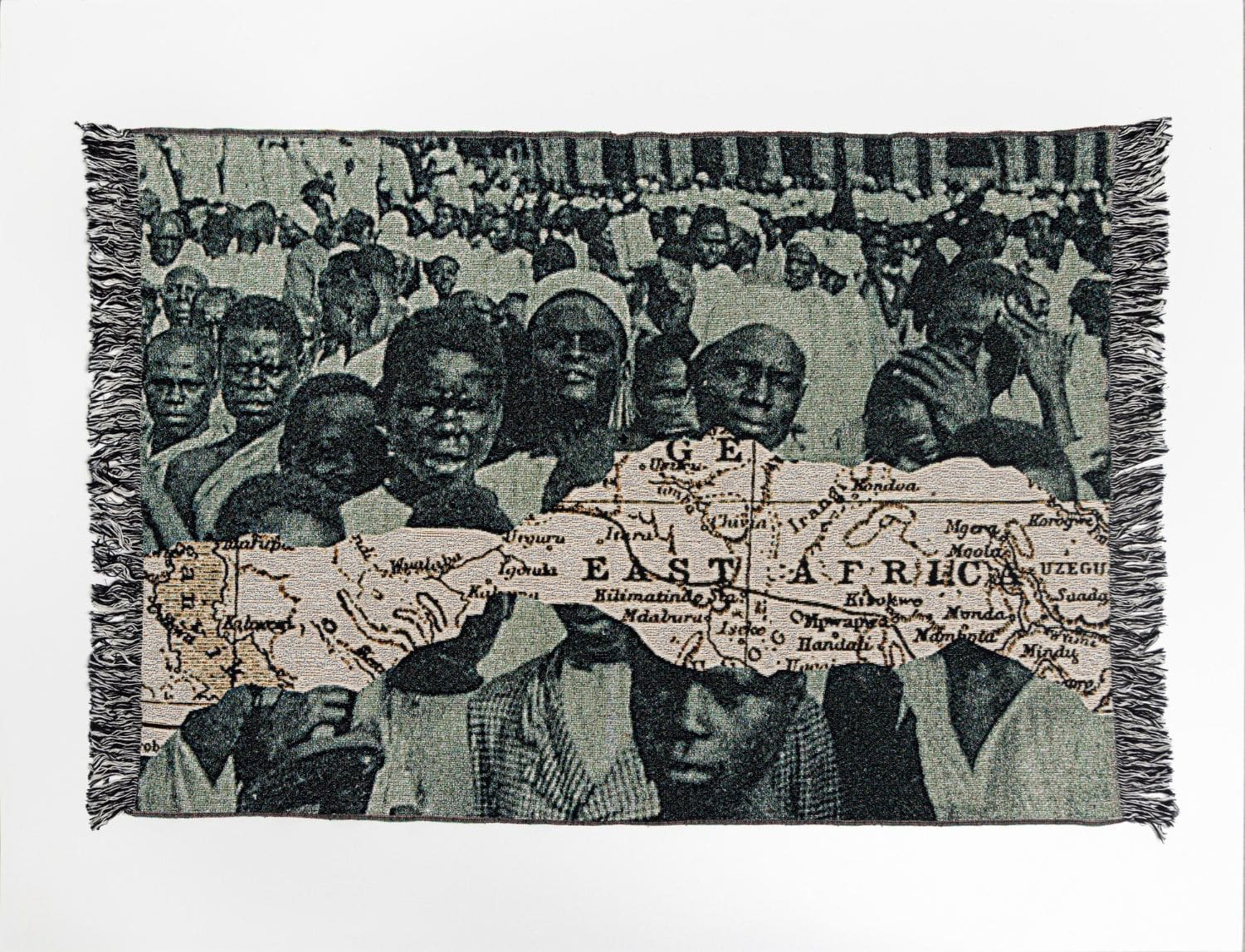
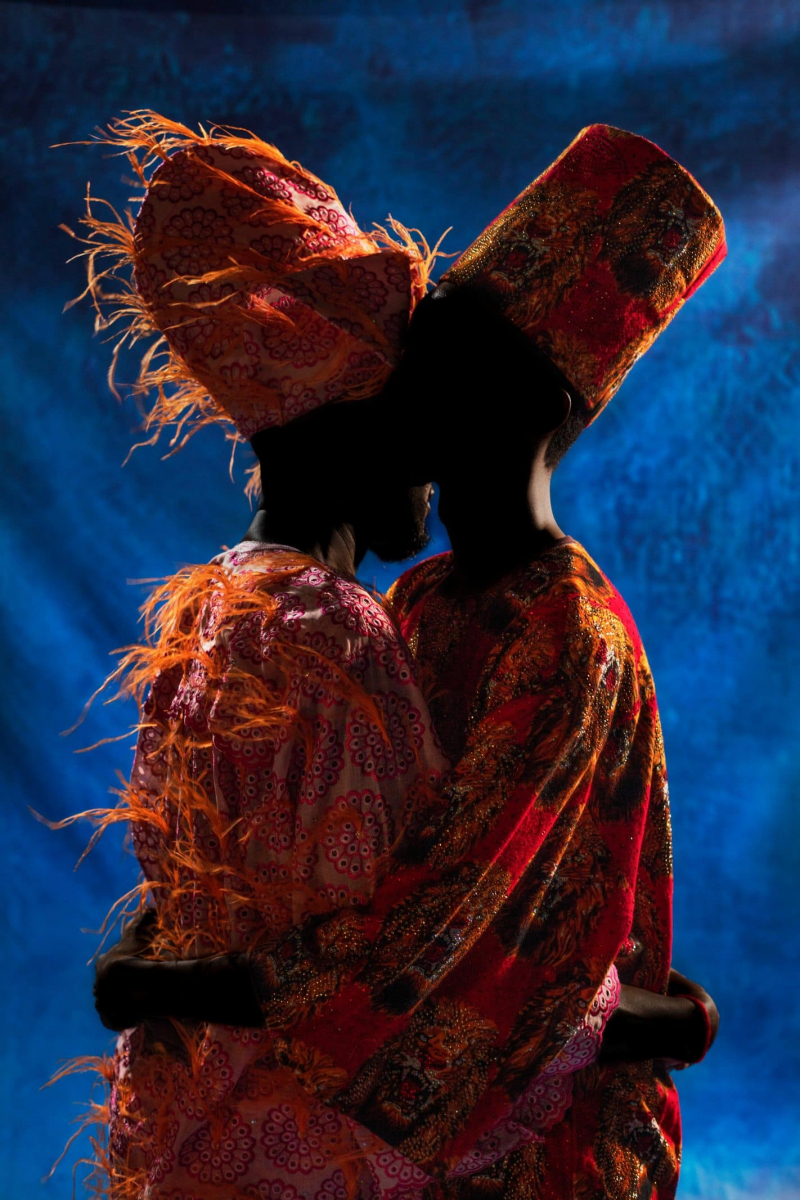
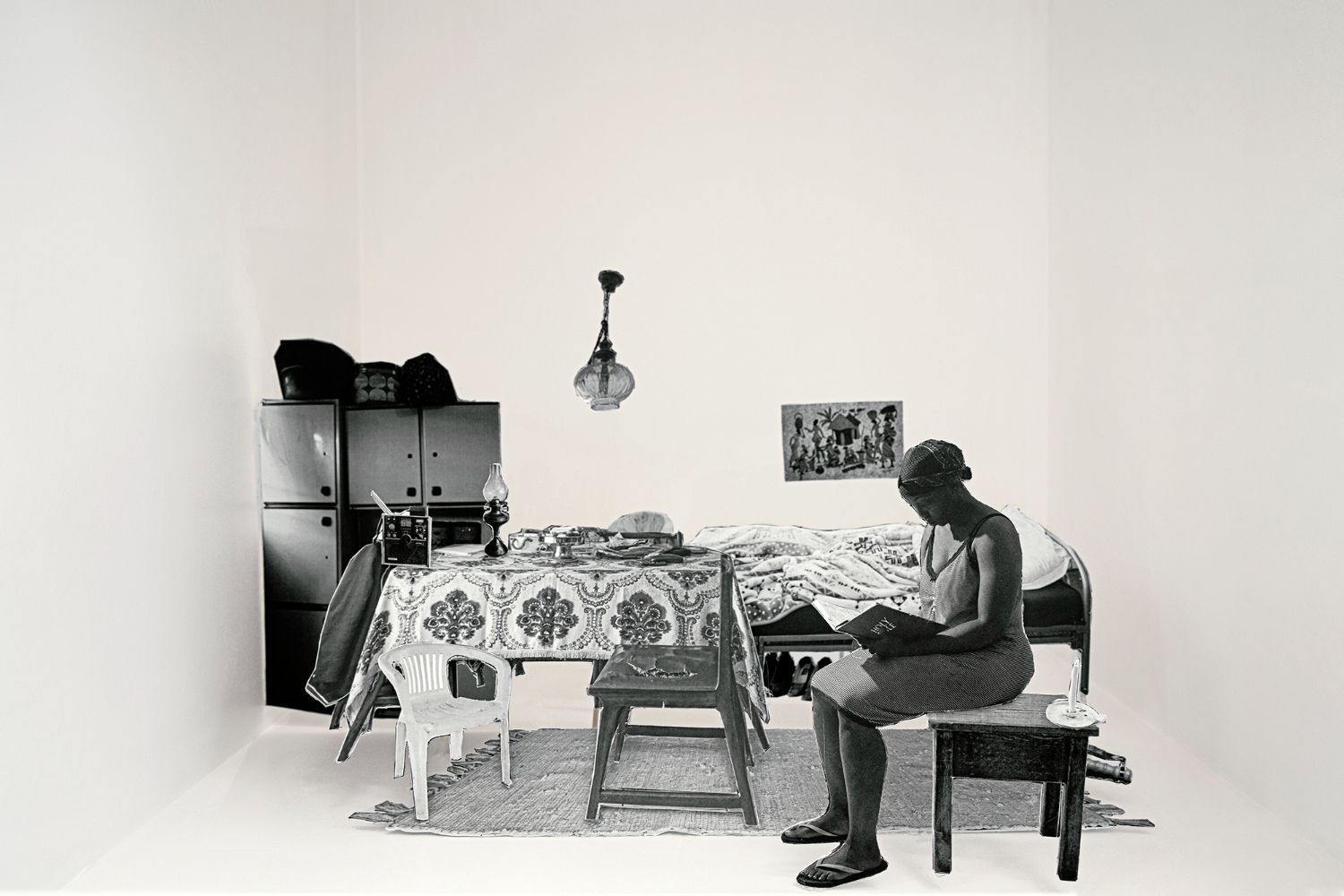
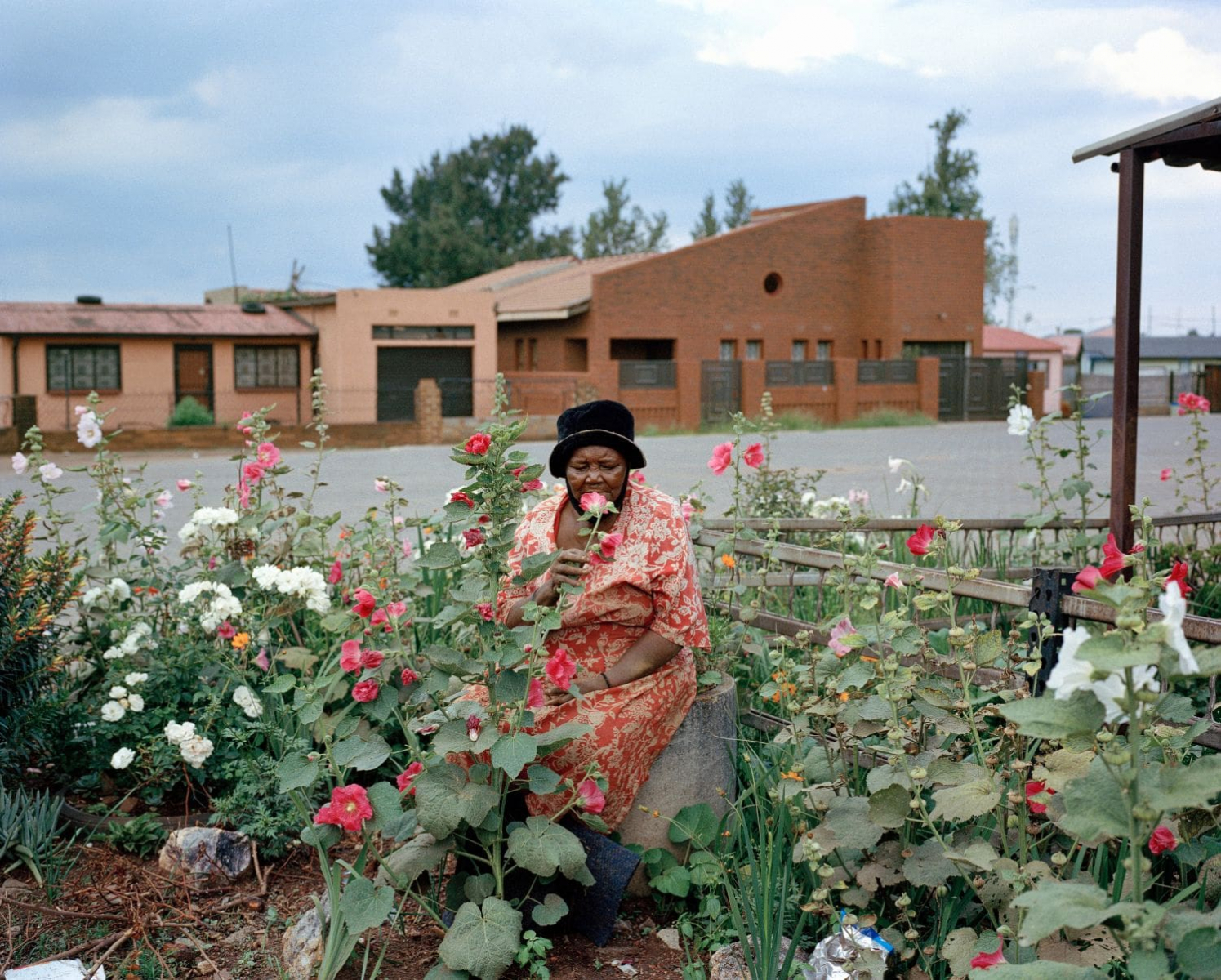
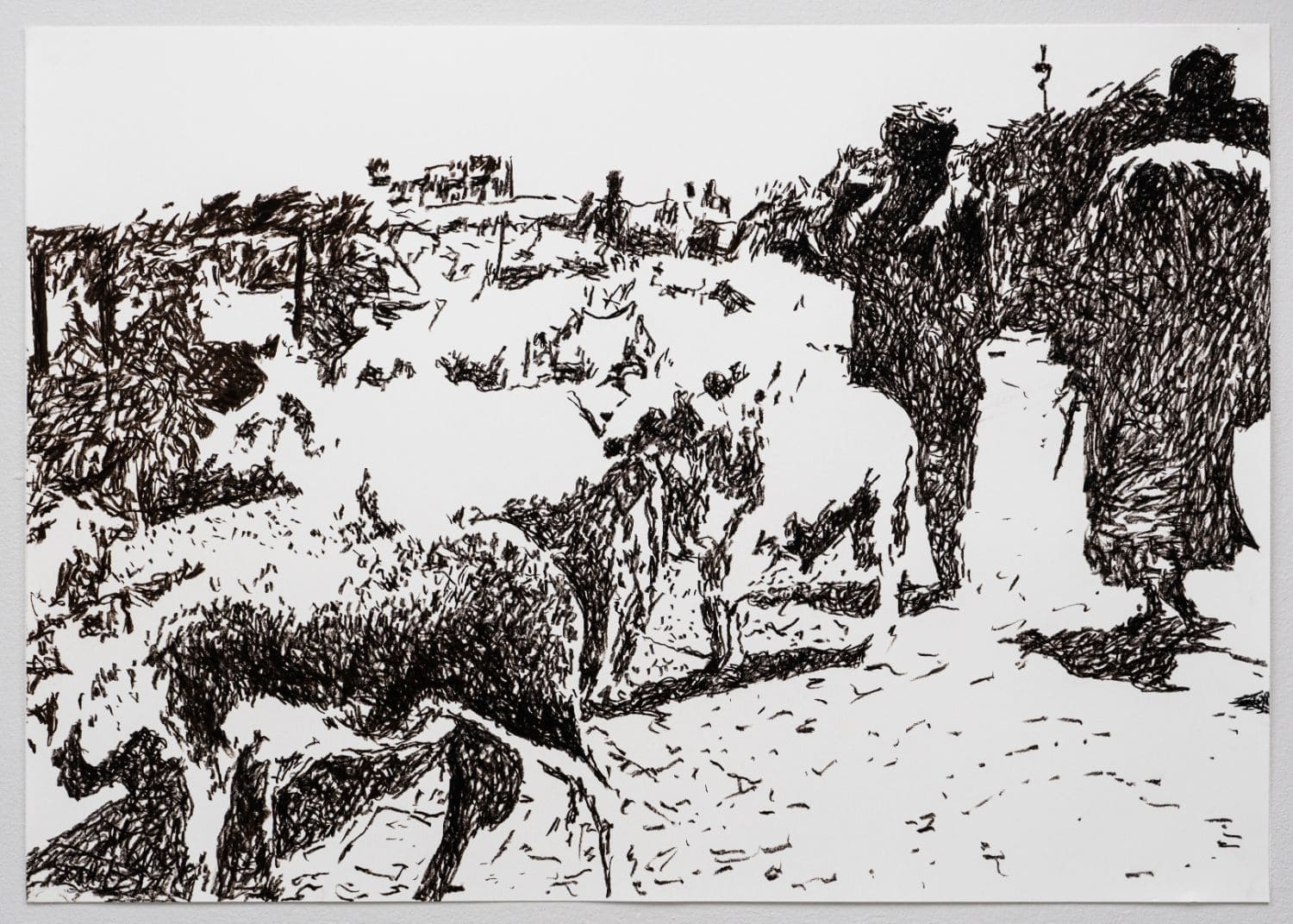
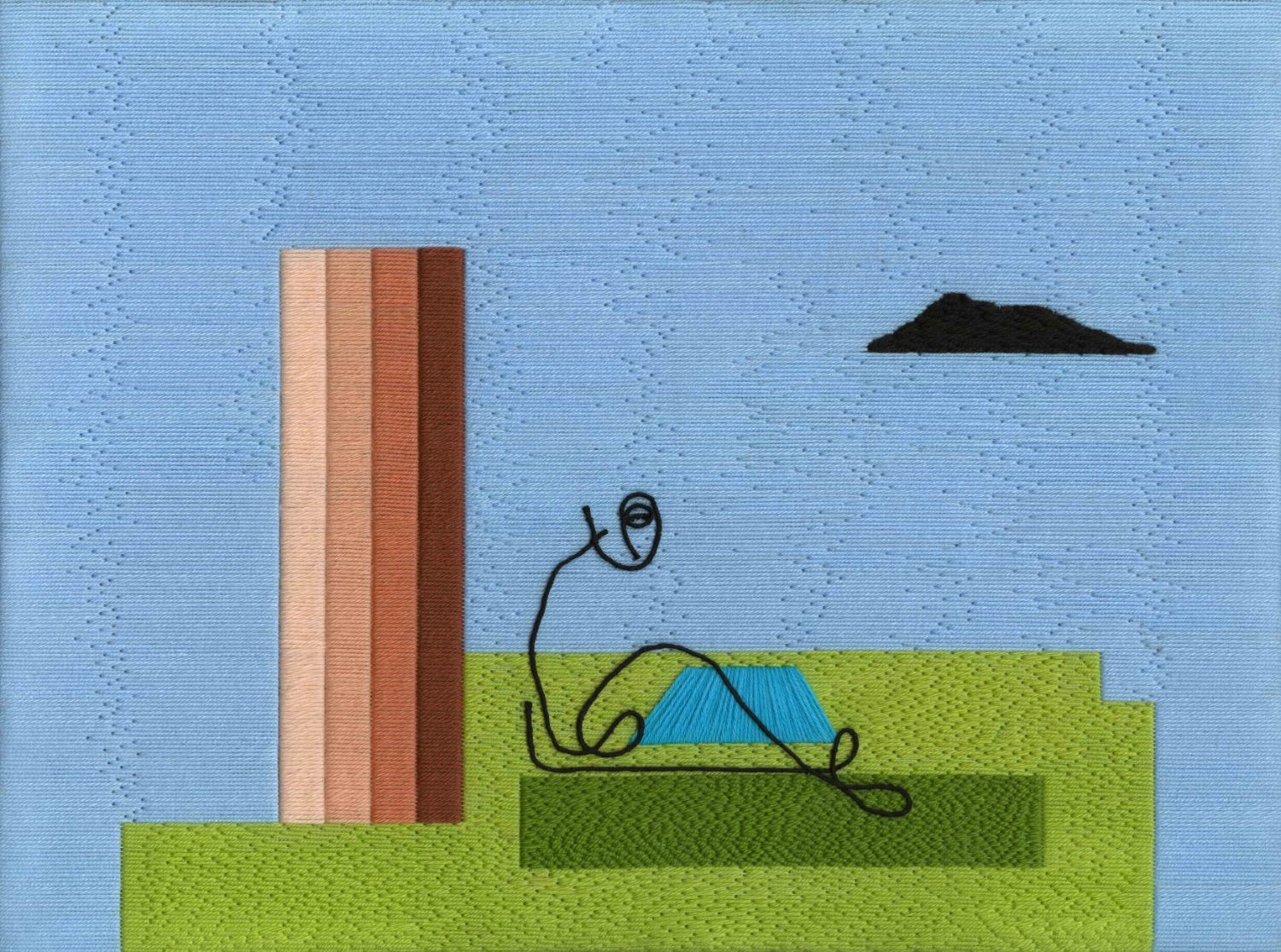
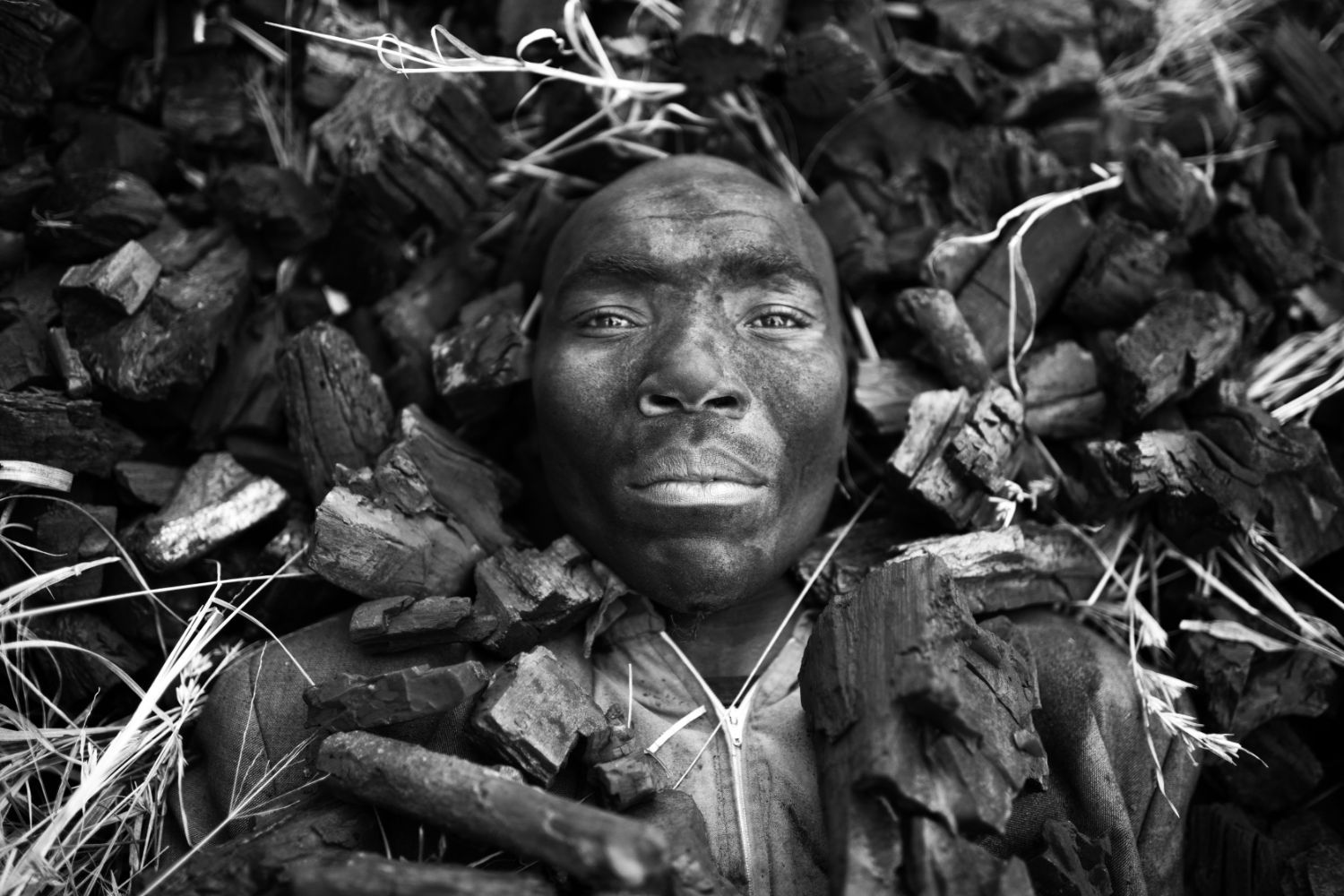
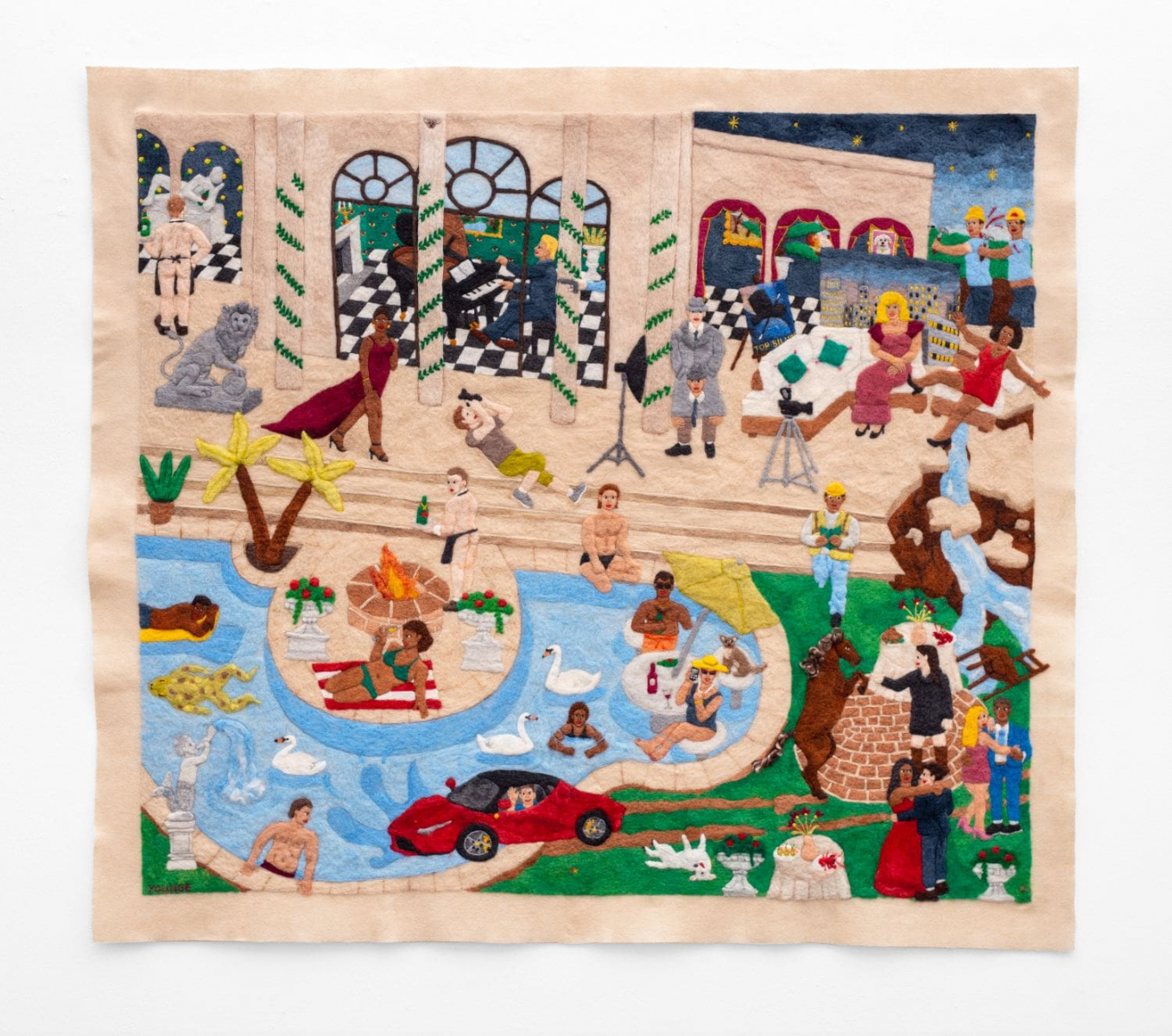
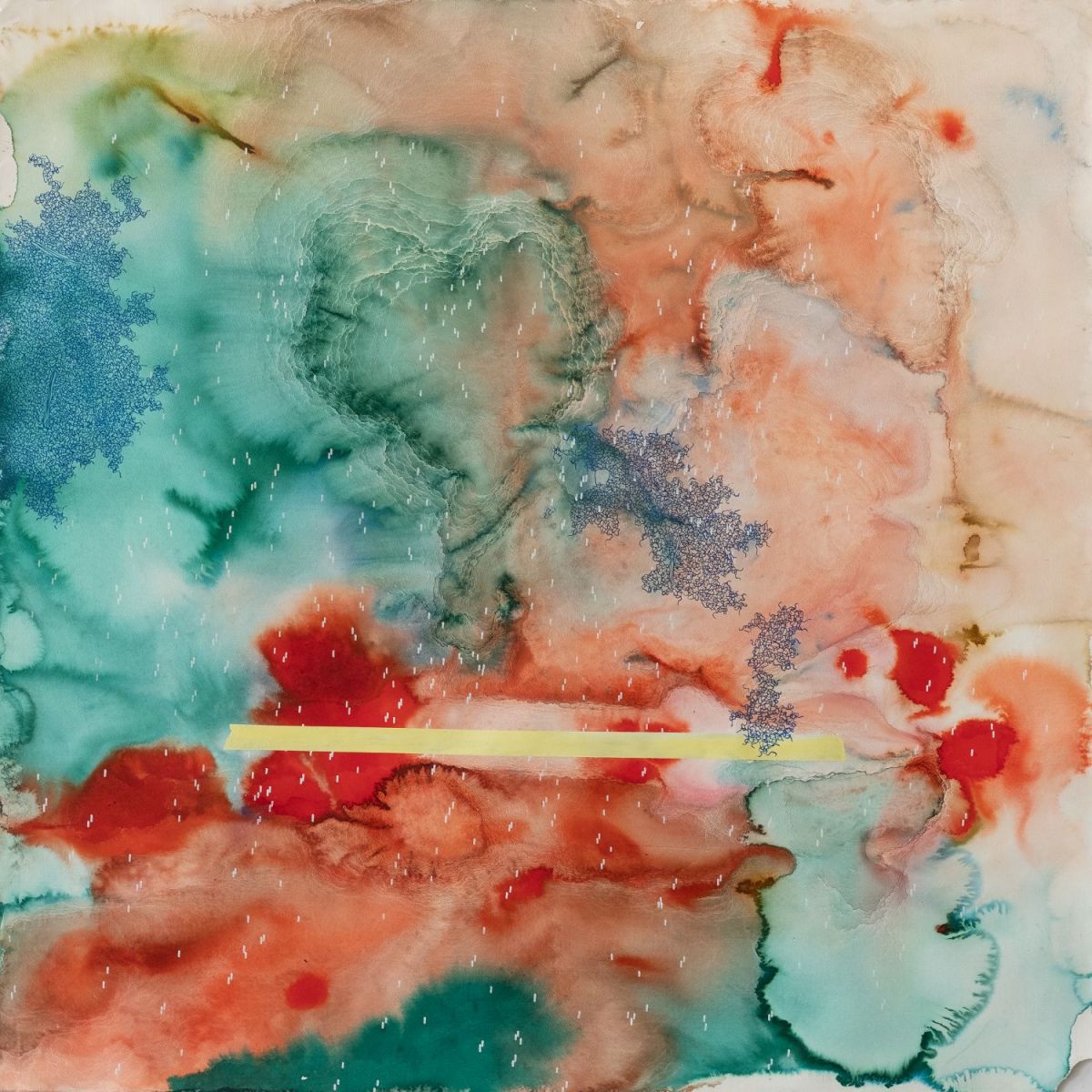
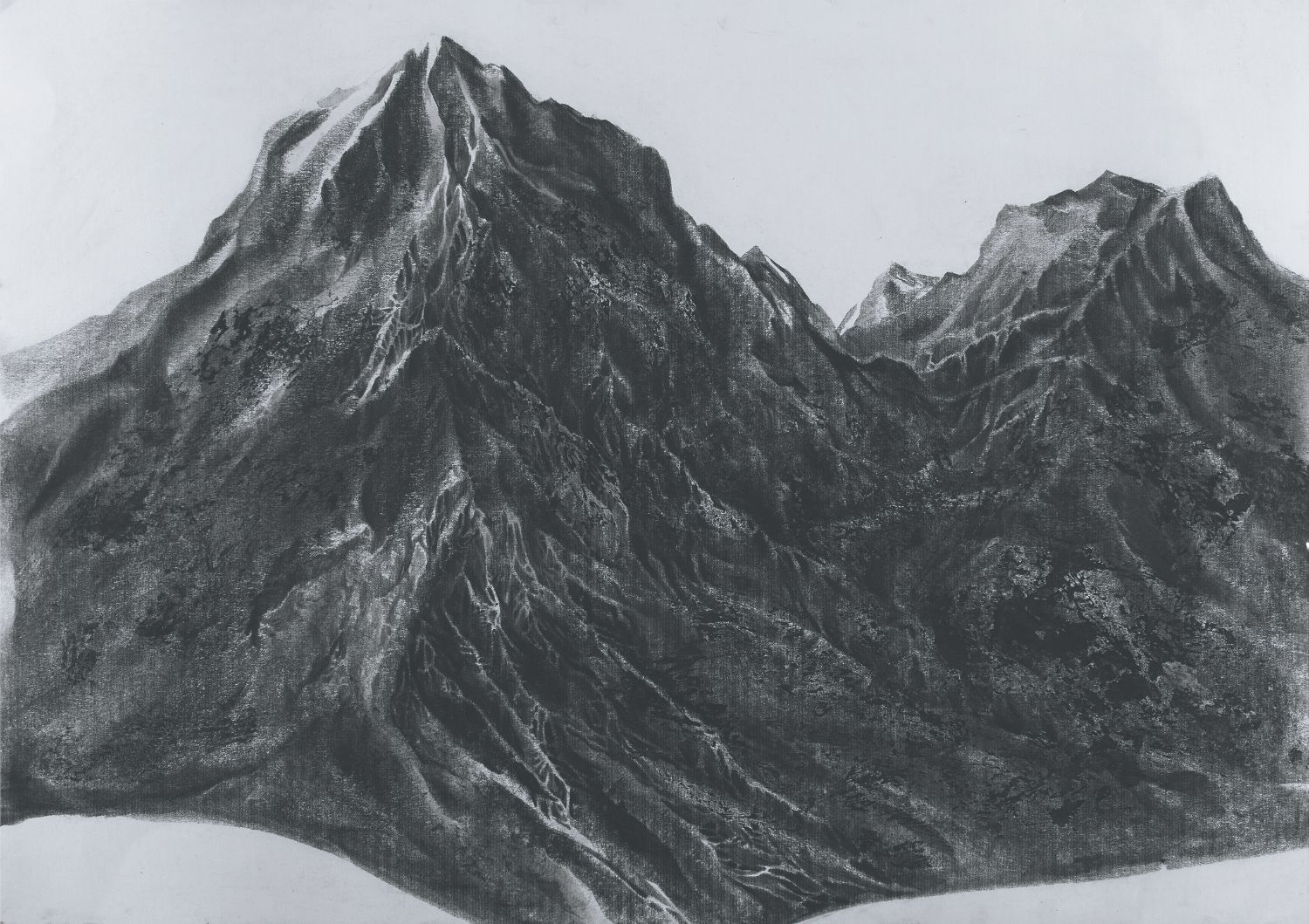
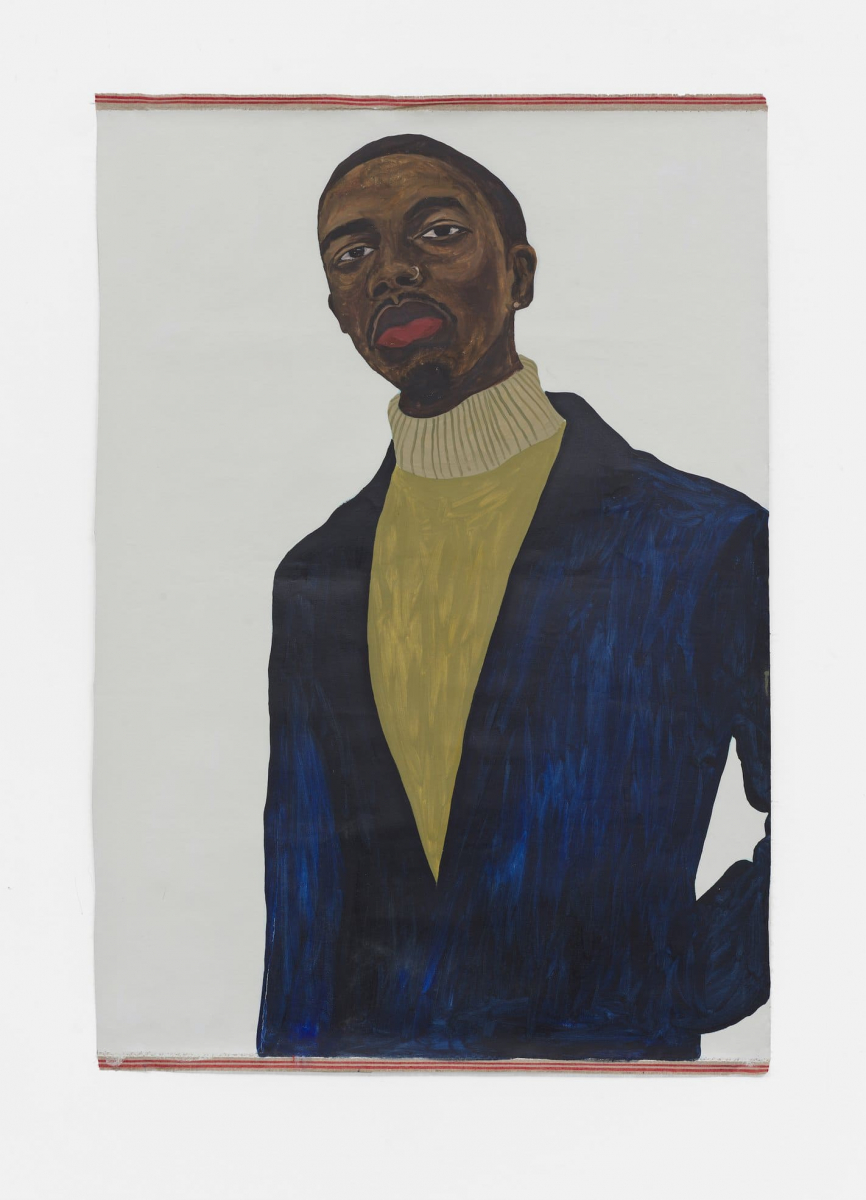
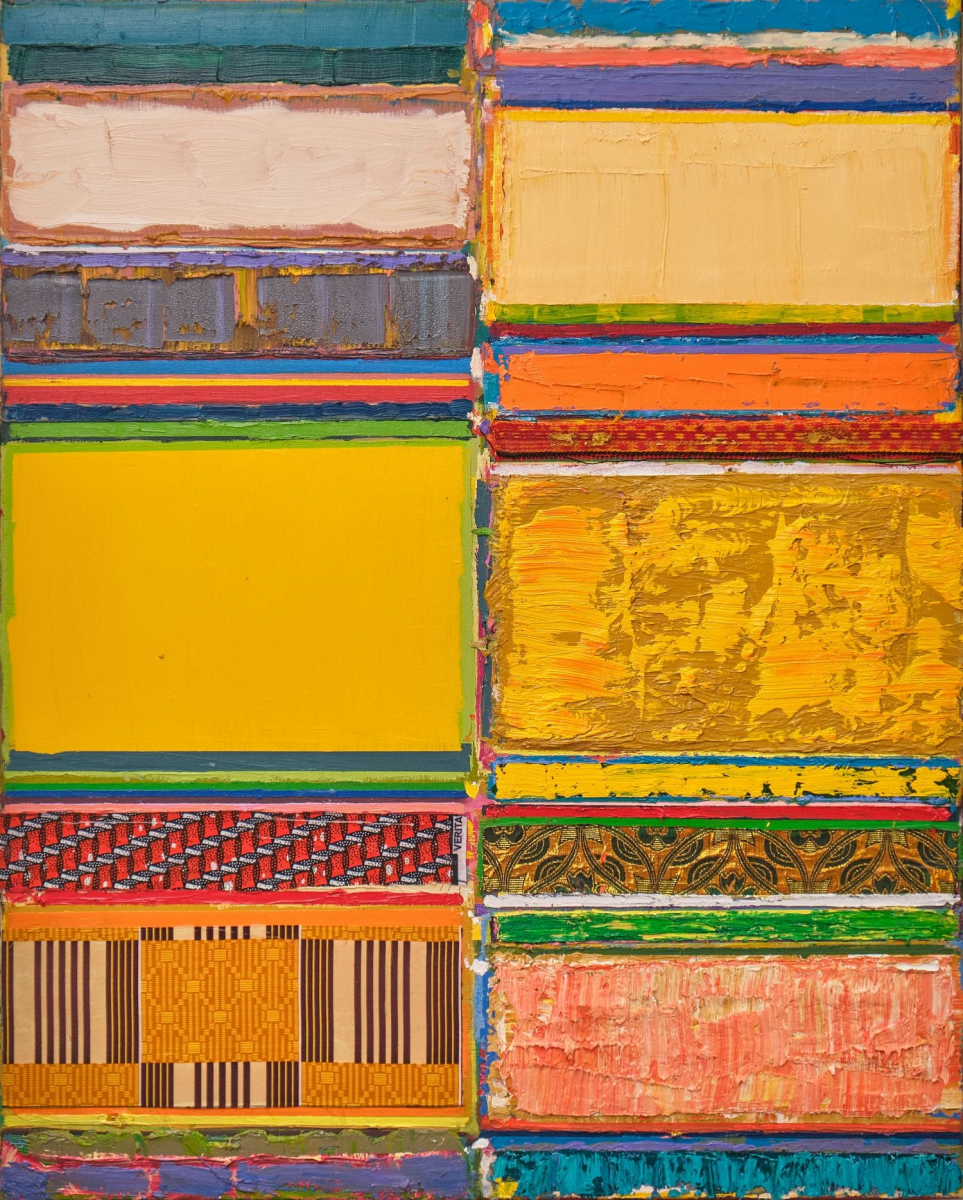
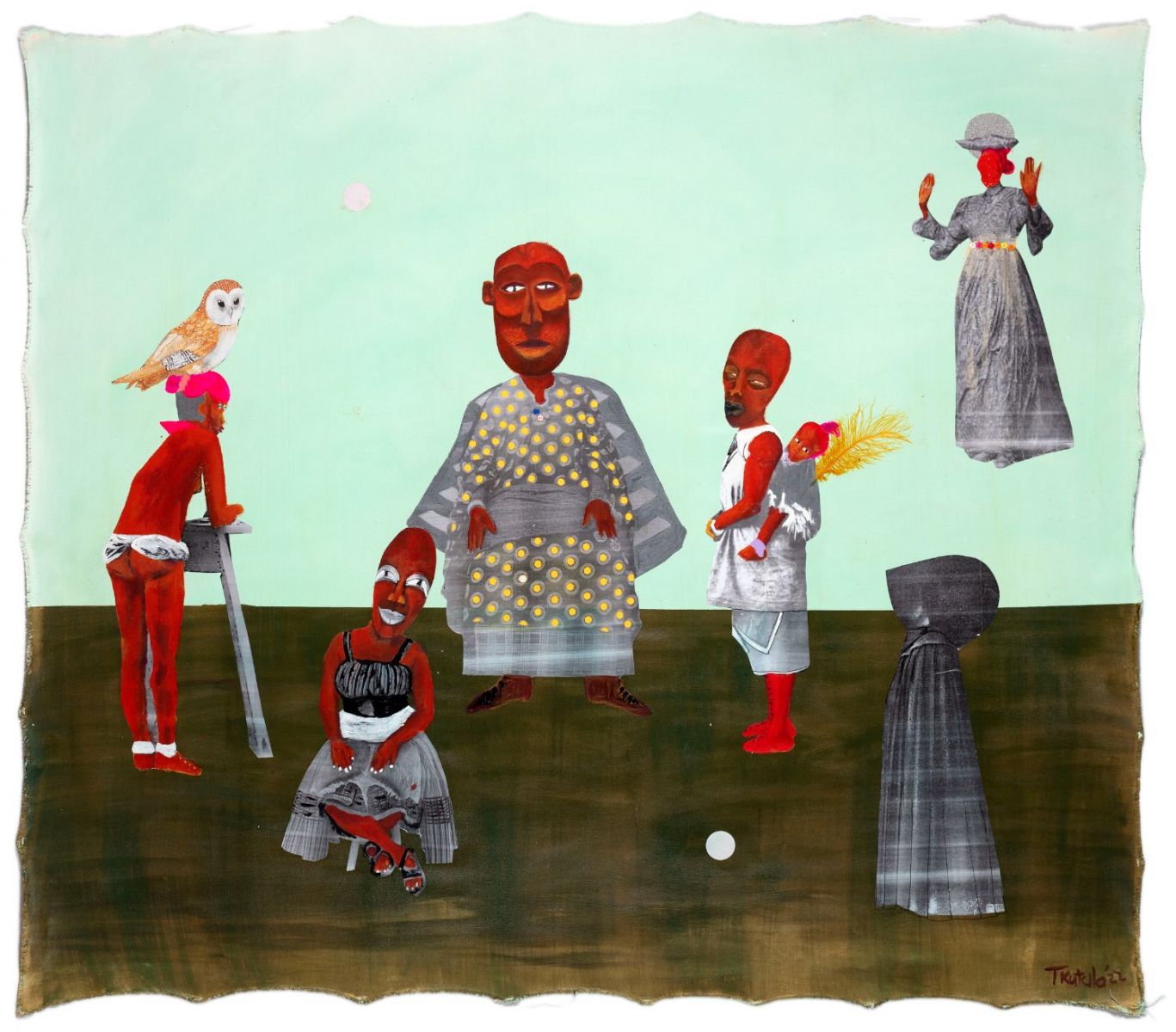
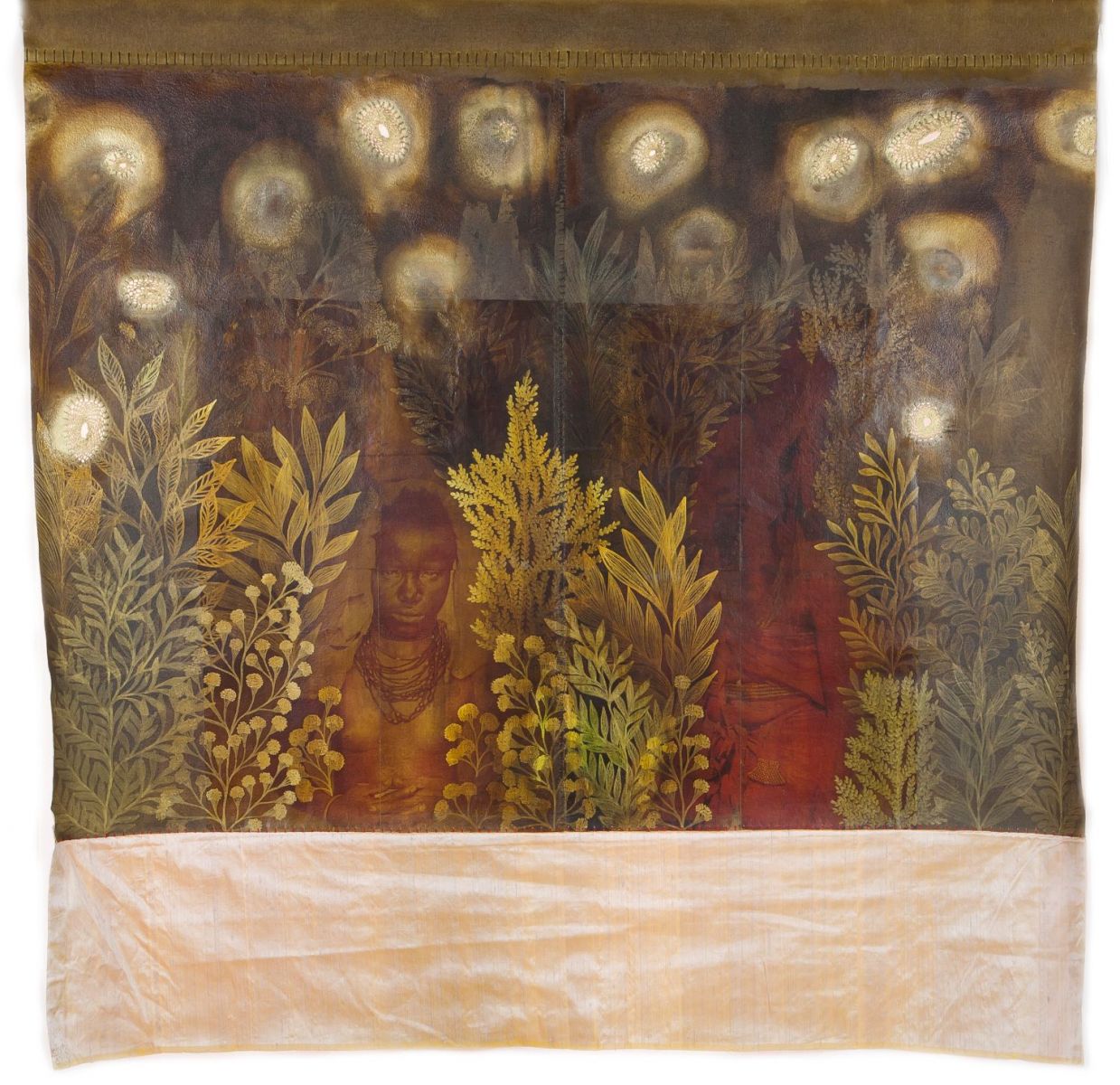
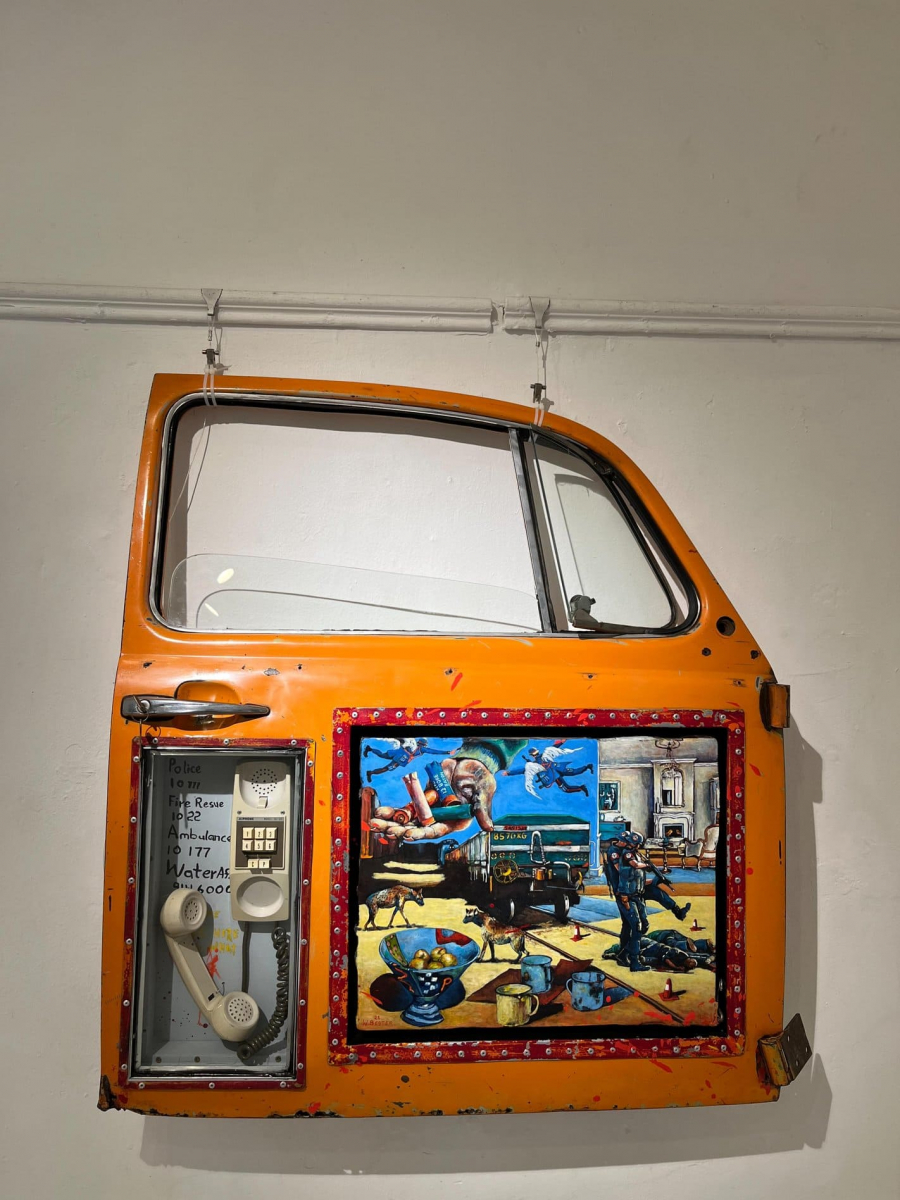
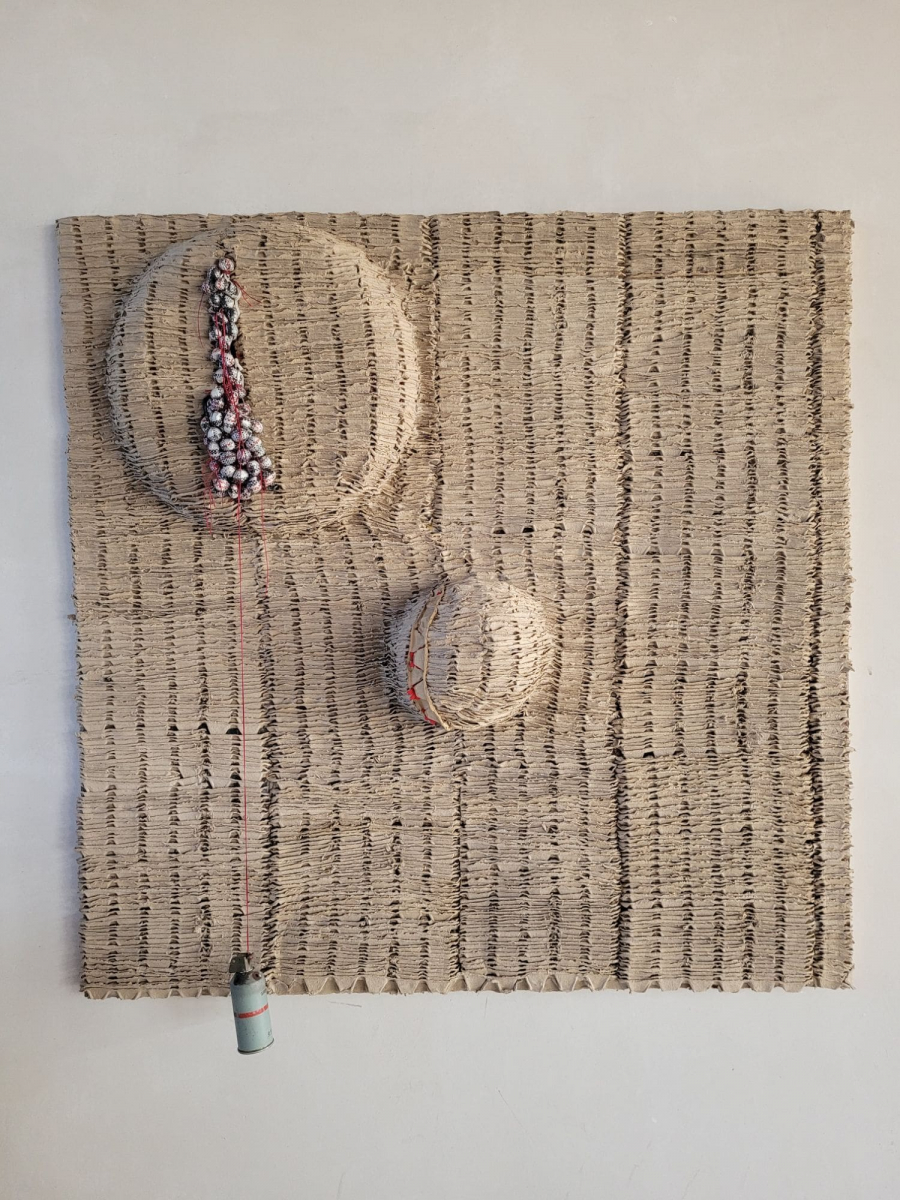
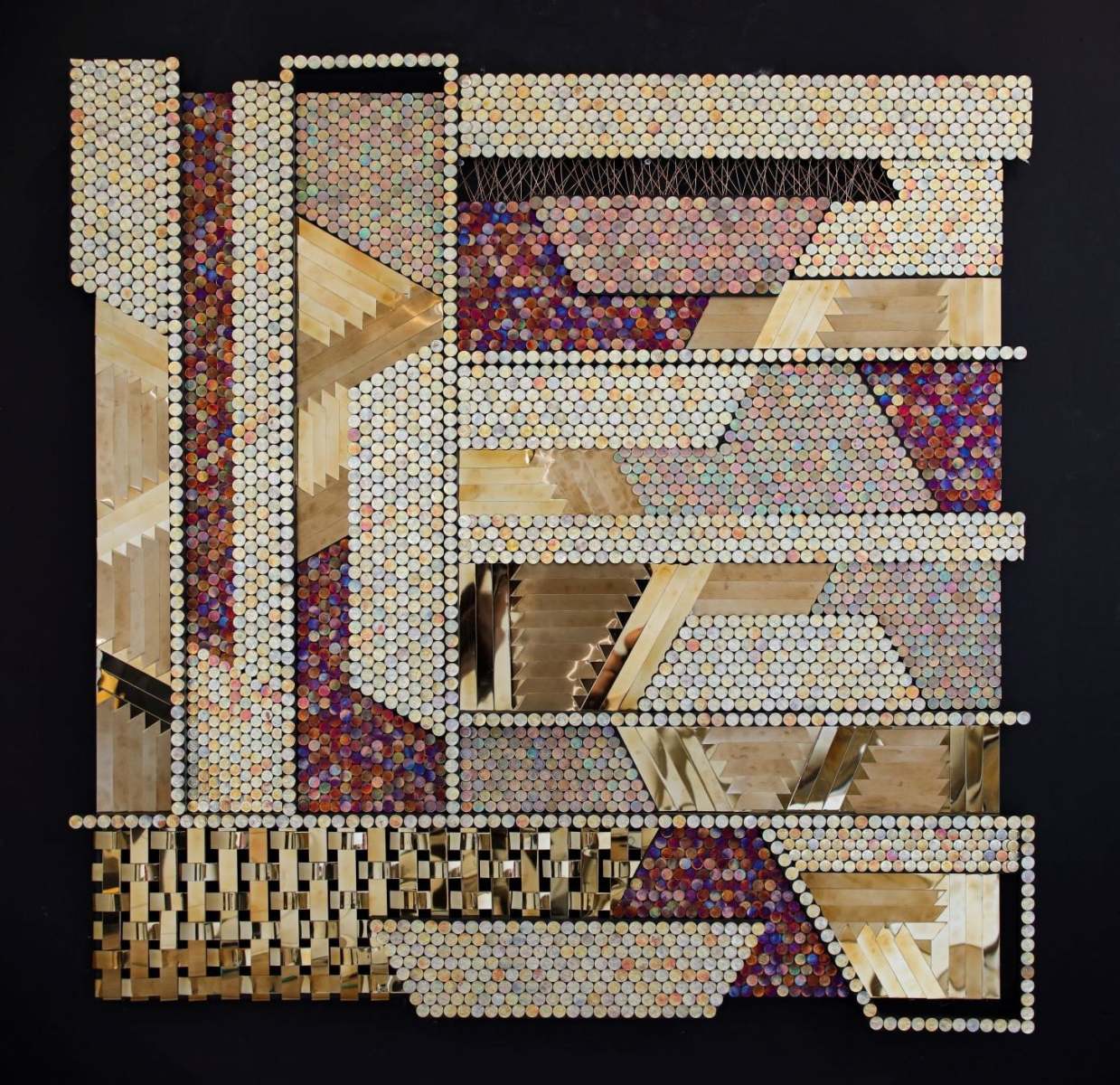



Alioune Diagne (b. 1985, Senegal) is an artist based in France who works primarily in painting and drawing. He employs calligraphic marks, often within strict geometric shapes, to create schematized images of largely figurative subjects. The marks of the artist’s own devising become a personal iconography that overlays each image. Both the foreground and background of his paintings are rendered in this way, but the type of mark and scale of the shape differs, creating a contrast between the two. This is heightened by bright and luminous tones, which are often applied to the background, and more muted tones applied to the figures. Diagne describes this overall technique as ‘figuro-abstro’.
The subjects on which Diagne focuses are numerous but often connected to his personal experience of growing up in Senegal and the wider experience of African diasporic communities in Europe, where he is now based. His paintings are populated by figures in West African markets or moving through the urban environment of Dakar. In XALÉ TEY – Enfants d’aujourd’hui (2021), which translates into “kids of today” in English, Diagne depicts two children that he met in the street in Dakar. Posed as if caught by a camera, perhaps to circulate on social media, this image highlights the evolution of customs in Dakar as well as a sense of playfulness and comradery that can be detected between the two figures.

Amy Rusch (b. 1990, South Africa) creates works by stitching together layers of found plastic bags, conceptually and materially bringing together different time periods and aspects of South Africa’s contemporary and historic cultures. Her current body of work is specifically informed by ocean crossings, archaeological excavations and microscopic studies of the living world. The works may be seen as mappings of lived-body experiences, becoming multi-sensory combinations of sound, vibration, line and colour. The artist finds a unique rhythm in the way that she works with her materials. The resultant pieces provide a retrospective link to the embodied experience transmuted through her creative process.
Seeing with a Listening Ear and a Question of Time (2022) is a transmutation of time spent on a koppie (small mountain) in South Africa’s Northern Cape province: a place abundant with rock engravings and archaeological material. Rusch’s time in this region was marked by the end of a seven-year drought – rain transforming the natural environment. The inspiration for this particular work speaks to a shared experience embedded in our collective memory – dry earth, responding to water and the resultant life-force reshaping a landscape.

Andrew Esiebo (b. 1978, Nigeria) is a visual storyteller and artist whose artistic practice explores the human condition and its relationship with urban space. Through an intimate gaze and close-up details of daily life in urban African contexts, such as Lagos, Esiebo seeks empowerment through the photographic medium and celebrates the endurance and survival of the people he portrays. His work brings together diverse creative strategies and highlights the complexities of identity, culture, sexuality and spirituality in contemporary African societies and the African diaspora.
A Tyre Never Dies: Mile 12, Lagos (2022) is part of an ongoing interdisciplinary project that addresses a global environmental challenge that is visible in Nigerian streetscapes: the ubiquity of end-of-life tyres (ELTs). The project explores the impact of ELTs on road ecologies while promoting social and technical solutions that create more sustainable urban environments and improve the well-being of its people. Specifically, the project explores informal cultures, livelihoods and technologies that arise from the presence of ELTs, as well as the economies of tyre repurposing. Conceptually, the project is concerned with tracing the role of consumer waste within a context where the automobile is the dominant mode of transport.

Arébénor Basséne (b. 1974, Senegal) approaches his work like imagined documents from the past, taking inspiration from the development of language and writing systems, fragments of history and archaeological remains. In an attempt to fill the gaps left in history and comment on one’s access to the past, Basséne has developed his own lexicon. The artist uses materials found in Senegal: Arabic gum (a historically attractive commodity to the foreign sailors), ink (used in Koranic teaching tablets), fouden (henna), crushed wood and natural pigments. These materials comment on history’s plurality as well as its falsifications.
Solstice 0 (2022) is composed of twenty-four works on paper which have been mounted on canvas. Mimicking the printing technique of batik—whereby patterns are drawn in wax on fabric and then the fabric is submerged in dye, leaving the sections covered in wax untouched—Basséne transforms the paper’s surface with multiple layers of materials, including natural pigments, wax, ink, sand, and sawdust. In Solstice 0, microscopic visions of earth’s base elements seemingly sit alongside macro perspectives of geographical areas, depicting deltas, desert dunes, and rivers. Each piece carries the illusion of history’s erosion, swept away by time.
Credit: Selebe Yoon Gallery

Cinthia Sifa Mulanga (b. 1997, Democratic Republic of Congo) is a painter whose work addresses questions of belonging and how we give meaning to the place(s) we call home, while drawing upon her own experience growing up in South Africa as a Congolese national. Focusing on black female subjects, Mulanga explores representations of beauty using the language of popular culture and historical painting. She depicts domestic spaces, often with multiple figures, which become a type of multi-perspectival portrait. Often the figures do not interact with one another; they seem engaged in their own thoughts and feelings, though never entirely unconscious of the viewer’s gaze. Through her practice, Mulanga plays with traditions of western painting, challenging the absence of black female figures.
In All my Emos (2022), Mulanga depicts different personas, emotions or states of mind that can occupy a single space or moment in time. Her intention is to highlight the complexities of female identity. References to Mulanga’s own work punctuate the painting, revealing her fascination with black women’s self-expression.

Dimakatso Mathopa’s (b. 1995, South Africa) practice is marked by an experimentation with historical forms of printmaking, including cyanotype printing. By using this technique, she confounds the colonial use of photography and explores the inherent violence of the gaze it imposed on black subjects. Her work is concerned with a shared narrative that is specific to the displacement of black people in South Africa. More specifically, her work references her maternal grandparents’ loss of their family home and the consequential break in generational inheritance of (and connection to) land. The only remaining evidence of this family narrative is through the artist’s late-grandmother’s embodied knowledge, passed down through oral transmission.
Individual beings Relocated IV (2022) is a depiction of one of these oral narratives. The story relates to her late-grandfather’s inheritance of land in the Free State from a local white man who was very fond of him. Mathopa’s late-grandfather had a wealth of knowledge in farming and served as a traditional healer for the community of Viljoenskroon. Thus, he was able to hold a position of influence in the community and had many relationships with the white people who inhabited the area which led to the gift of land bestowed upon him. In Individual beings Relocated IV, Mathopa reimagines herself in her late grandmother’s position as the matriarch of the inherited household. The cyanotype’s sepia look has been achieved by using different teas, that her late grandmother always drank in the kitchen.

Dr Esther Mahlangu (b. 1935, South Africa) is a multi-award-winning visual artist and South African cultural ambassador. She has been painting since she was ten years old when she was taught the art of house painting by her mother and grandmother, as per the tradition of the Ndebele nation. A visionary and disruptor from an early age, Dr Mahlangu recognised that, by reimagining the geometric patterns typically used to decorate houses onto contemporary media, she could create artworks that were more accessible to global audiences. Mahlangu went on to paint canvas, cars, motorbikes, mannequins, World War II helmets and more. The resulting works combine traditional techniques with elements of popular culture in a style unique to Dr Mahlangu that graces important collections around the world.
Dr Mahlangu’s abstract paintings follow the laws of sacred geometry. Patterns, shapes and colours are applied in flat acrylic paint in order to create balance and harmony. Straight black lines work to outline the shapes of bold colours. The white of the canvas remains untouched in order to accentuate the painted areas. Whilst her early works were created using natural pigments and dyes and painted with a feather, developments in acrylic paints opened up an exciting palette of colours which inform the vast majority of her works. Ndebele Abstract (2021) is one example of Dr Mahlangu’s iconic abstractions, honouring the legacy of her ancestors, including her mother and her grandmother before her.

In his paintings, Famakan Magassa (b. 1997, Mali) fluctuates between satire and empathy as he comments on issues of violence and vice. Magassa often refers to his subjects as ‘kôrêdugaws’: members of a secret, non-religious society in Mali whose initiates function as wise fools or playful tricksters in their communities, engaging in humourous behaviour in order to spread messages of community, generosity and humility. Taking their cue, Magassa portrays his subjects in a grotesque yet comical light, capturing the absurd and often contradictory nature of a society in which tradition and modernity clash.
In La ballade noctambule (2022), a woman carts her inebriated partner off in a wheelbarrow. Her gaze into a dark, starless sky suggests an overall sense of exasperation, while her single stiletto, the cart’s misshapen wheel, and the drunkard’s lolling tongue irreverently lighten the mood. In this work and others, Magassa uses morbid humour to discuss difficult themes such as addiction, desperation and conflict.

Gresham Tapiwa Nyaude’s (b. 1988, Zimbabwe) colour-rich, figurative paintings use comedy to reflect on identity, politics and consumer culture. He believes his comedic perspective is typical of being Zimbabwean, where proverbs, myths and slang help one survive in a place where the personal and political are painfully intertwined. Nyaude processes these inner and outer conflicts using various symbolic devices and bold, colourful gestures. His work is coded with references to Zimbabwe’s history of painting as well as its popular and political culture, an act of defiance in the context of a country often marginalised and misunderstood.
Strength of Character (2022) is a personal response to Hamlet’s “To be or not to be?” As per the Shakespearean trope, the painting depicts a skull beside a bottle of poison, which a skeleton contemplates, raising the question of what it means to choose life (or death) in fragile or turbulent circumstances. The artwork also references the tradition of the memento mori from antiquity to the contemporary.

Huda Lutfi (b. 1947, Egypt) is a historian and artist who works in a wide range of media, including collage, assemblage, painting, photography, sculpture, installation and video. She is interested in the physicality of materials as well as the symbolic associations imbued within them. By recycling, re-appropriating and re-imagining objects outside their original context, Lutfi subverts the political, cultural and economic systems that produce meaning. Her frequent use of feminised objects such as dolls, thread, mannequins and magazine clippings conveys her artistic as well as academic interest in constructions of masculinity and femininity.
Entropy (2021) is a hand-embroidered work that invokes feminine traditions of craftsmanship and honours the labour involved therein. While this mode of creation is traditionally practised communally amongst women, Lutfi reverts to solitariness. The labour of stitching and sewing thus takes on a more self-reflective meaning. Toying with the possibilities of entropy, Lutfi’s tapestry is informed both by the meticulousness of intention and the joy of experimentation.

Artist and film director Hamedine Kane (b. 1983, Senegal) is concerned with issues of memory, migration and mutation. Through research and fieldwork, he interrogates liminal spaces – geographical borders, historical palimpsests, places where the past and present intermingle – as sites of transformation and itinerant identities.
The School of Mutants 1 (2021) is a photograph of the abandoned campus of the African Future University. The work forms part of a broader research project, L’École des Mutants, a collaborative art and research platform co-initiated by Kane and artist Stéphane Verlet-Bottéro in Dakar. The project revolves around the forgotten history of radical educational experiments in Senegal. The futuristic ruins of the University of the African Future, a pan-African academic utopia co-financed by many African states and Taiwan in the 1990s, stand abandoned in Sébikotane, a rural suburb of Dakar. Not far away are the remains of the colonial school William Ponty, where the first West and Central African independence fighters were trained. The resulting image is charged with the convergence of past, present and future possibilities, while the uncompleted campus stands as a monument to dreams deferred.

Januario Jano (b. 1979, Angola) is an interdisciplinary artist who works across sculpture, video, photography, textile, sound installations and performance. His research-based practice interrogates the delicate balance between fiction and reality, human and non-human coexistence. In this context, Jano is interested in the role of the body as a representation of globalisation and cross-cultural dynamics. Much of Jano’s work engages with Angola’s cultural reinvention, realising the need for creative interventions that facilitate innovation within postcolonial contexts.
System 001 (2021) explores objects that have an uncanny relationship to the body and self. Textiles, thread, silkscreen-printed photographs, Catholic iconography, European ceramics and rope converge to reflect on notions of hierarchy and heritage. The use of fabric is central to Jano’s practice because of its ability to store memory, their tactility and their many applications. Ultimately, Jano is interested in the threads that connect the past to the present, resulting in mixed media works that reflect hybrid notions of identity.

Multimedia artist Jeanne Gaigher (b. 1990, South Africa) uses intricately constructed figurative paintings to interrogate the body as both a situation and a consequence. The process of constructing the canvas is a highly intuitive one, involving labour-intensive practices of cutting, sewing, and ironing. The scrim (or gauze-like fabric) obstructs and shelters the bodies in her work. The layering of materials mimic layers of sediment or debris that has built up over a long period of time, conjuring a macabre topographical tapestry of the body.
The Love Object (2022) revolves around our disorientating, intimate and often cryptic relationships to the body and its terrain. In the face of a consumer culture that elicits shame around the body’s organic processes of transformation, Gaigher allows her figures to respond in unexpected and, at times, supernatural ways.

Jess Atieno (b. 1991, Kenya) utilises mixed media techniques to question place and belonging in post-colonial Africa. In these explorations, Atieno time travels through historical photographs and maps, reappropriating them into serigraphs and tapestries. The materials from these archives contain traces of violent histories and repressed narratives. In mining them, Atieno seeks not to heal, but to investigate how the past continues to haunt the present.
In Take me to your river (2022), Atieno represents what it means to belong to a place through the lens of a colonial past. Atieno appropriates archival photographs and maps into a woven tapestry in which she invokes the symbolic power of the flag. Employing the gestures of fragmentation, weaving and collage, the artist questions the flag’s historical foundations that continue to inform our sense of identity, citizenship and agency. By replacing the flag flown with the carpet laid down, Atieno creates a potent symbol of our collective and individual agency.

Photographer Lakin Ogunbanwo (b. 1987, Nigeria) creates enigmatic portraits, bridging a gap between fashion editorials and classical portraiture. His enigmatic images hold amorous and subversive undertones in which his subjects’ faces are usually obscured from view, often masked by shadow, drapery or foliage. The use of vibrant, flat colours and bold compositions forms a more minimalist homage to African studio photography that became popular in the 1960s and 70s.
I see it, do you? (2021) portrays Ogunbanwo’s desire to self-represent African narratives by documenting the complexity of his hometown, Lagos, and its culture. Using veiled portraiture and fashion as cultural signifiers, the artist intends to counteract the West’s monolithic gaze on Africa.

Lebohang Kganye’s (b. 1990, South Africa) artistic practice revolves around her interest in photography, performance, theatre and literature. She incorporates the archive and orature as source materials in order to tell stories and revisit memories that play out in the familial experience. The act of remembering through imagined narratives evokes a set of enquiries in which both subjective and shared histories play a key role.
Her voice muffled by the soil (2022) is part of a photographic series In Search for Memory, of miniature cut-outs arranged within sets done in the style of pop-up books or shadow theatres. Reinterpreted from Malawian writer Muthi Nhlema’s short story Ta O’Reva, Kganye portrays a hypothetical future in which Nelson Mandela returns to a South Africa destroyed by xenophobia and a genetically modified virus. The artist play several roles integrated into the scene of several photos taken during successive trips to old industrial areas between Pretoria and Johannesburg. In Search for Memory dramatises the impact of big history on small stories, both familial and personal, and reflects on how we construct and articulate our memories.

Photographer Lindokuhle Sobekwa (b. 1995, South Africa) deals with themes of social injustice in the townships of South Africa and, more recently, a deeper look at his personal life. Sobekwa’s most recent photo series documents meaningful places and people in the countryside, leading him on an investigation of his roots.
Ezilalini (The Country) Gogo Lucy Zwane in her garden (2021) is part of a larger series which explores the area around Tsomo, a community in the Eastern Cape. Tsomo is the place where Sobekwa’s sister Ziyanda grew up. It is also a place his family called home. As the artist worked on the series about his sister’s estrangement from the family (and, ultimately, her death), he found himself returning to the Eastern Cape often to look for answers. What he found was a sense of reconnection to culture, identity and family. “Ezilalini” refers to what many people see as “home” in the countryside, rather than the cities (such as Johannesburg) in which they make their living. The artist draws our attention to the deep fragmentation in families and communities caused by the need to make a living in urban centres and recognises “Ezilalini” as the spiritual place of his elders and ancestors.

Mbaye Diop (b. 1981, Senegal) works across media, usually presenting his work in black and white. Often, the artist uses serigraphy and draws on various supports such as wood, cardboard or wall. While Diop’s work draws from the sociological and environmental phenomena occurring in his home country – including immigration, environmental changes, urban cluttering and the neglect of architectural heritage – he also reflects on his own experience of displacement in Switzerland. His work witnesses changing paradigms in African societies, namely the dichotomies between social media and ancient practices, virtual realities and African traditional customs.
Xaar (the wait) #2 (2022) is a drawing made with graphite that evokes scenes of an extremely popular and dynamic market in Dakar. Markets in Senegal are points of convergence in which people gather to buy, sell and negotiate. The streets become a sort of waiting room where sellers hope and animals await their final execution. This moment of waiting recalls the weeks prior to the Muslim celebration of Tabaski (Eid al-Adha). Owing to shifts in urban legislation, the city’s curbs become host for all sorts of urban phenomena at a time when Dakar’s informal markets are threatened by real estate and developmental pressure.
Credit: Selebe Yoon Gallery

Although Micha Serraf’s (b. 1994, Zimbabwe) practice is rooted in photography, his expanded work takes inspiration from techniques relating to his paternal Moroccan heritage. Through his work, Serraf processes the trauma of his family’s migration from Zimbabwe to South Africa, probing imagined memories in pursuit of identity and a place to call home.
The design of If we do not dream, we cannot rest (2022) is loosely inspired by the geometry of Moroccan Azemmour embroidery, a specific type of embroidery that was created by the Moroccan Jews whose ancestors, like the artist’s, fled the Spanish Inquisition. The work is inspired by a poem Serraf’s father had once translated for him which described a sky so flat that it felt as though not even life itself could ripple it. This piece reflects this sentiment by depicting a sky that is rippled by life and a swimming pool extending beyond the flatness of reality. A black cloud is merely a distant island. The overall feeling invoked is one of nostalgia towards the seemingly unfamiliar.

Mário Macilau (b. 1984, Mozambique) specialises in long-term photographic projects that highlight the voices of socially isolated groups (largely in Mozambique), casting a light on broader issues that impact their experience. Macilau explores the ways in which conditions of labour and cultural heritage are articulated through the environment in which people live, and the relationship that people have to that environment.
Nadinho Cossa, 34 years old (2021) depicts a man whose community needs wood and charcoal to sustain themselves while, in the process, deforestation is impacting their environment. Raising questions about conservation versus survival, Macilau comments on the realities of environmental exploitation and pernicious legacies of colonialism on indigenous communities.

Michaela Younge (b. 1993, South Africa) is a textile artist who currently lives and works in Cape Town. Using needles, she creates tightly packed, colourful merino wool tableaux that often depict humourous, dreamlike narratives that reflect the absurdity of human vices, violences and obsessions, and attempts to find meaning.
The party was underway, when the waters began to spray, the couples continued to sway and fill available ashtrays (2022) depicts an elaborate party scene. Class divides are highlighted through the farcical behaviour of the attendees and the high expectations placed on the employees. The party can be seen as a collective escapism from daily life, where alcohol fuels confidence, transgressions are often overlooked, and excess is encouraged. It is this excess – illustrated through drama, lust and violence, that underpins Younge’s commentary on the profligacy of the South African ruling class. The overlapping scenes are satirical and surreal, yet they maintain a chilling familiarity of a preferential social system where the divide between the rich and the poor only continues to widen.

Mongezi Ncaphayi’s (b. 1983, South Africa) process-based practice is primarily based in abstraction with minimalist qualities that combine drawing and painting. Often inspired by the rhythmic intonations of music, his linework and mark-making express his interest in jazz. With a background in print-making, Ncaphayi has developed a unique visual language resembling a topographic layout of blurred map-making. Persistently transcribing his understandings through his own codes, Ncaphayi engages with ideas of communication, translation and interpretation in an effort to find meaning.
Joy In Spite Of Everything II (2022) explores the inequalities faced by displaced, marginalised and deprived communities around the world due to political greed. The inspiration is taken from a record album by Charlie Haden and Hampton Hawes titled As Long As There’s Music.

Saïd Afifi (b. 1983, Morocco) is an artist living and working in Morocco. He takes an experimental approach to paper drawings, using lead or graphite to reframe, or resettle, digital data. The use of simple pencils containing lead is far from insignificant. Unlike charcoal, which originates from plants, lead comes from rock which itself traces its origins to exploded stars. As such, Afifi’s work is concerned with notions of time, while oriented towards the issues of natural landscape, biomimicry and the impact of new technologies in the observation of the world.
Géomorphologie d’un exo paysage : Relevé 32 (2021) derives from a satellite view of earth, reconfigured by the artist’s gaze. Just as the user of Google Earth can choose to zoom in on an area of their choice, Afifi sometimes manipulates relationships of scale, privileging one form over another.

Serge Attukwei Clottey (b. 1985, Ghana) is a multidisciplinary artist living and working between Accra and Los Angeles. Although his main practice involves his unique revisioning of scrap materials, his work delves into questions of image-making, representation and identity as well. His sensitive oil paintings are inspired by mid-century black and white photography made on the coast of West Africa, updating its visual language with figures who express the contemporary moment.
High Neck (2022) is a portrait painted in oil on canvas. The work draws on imagery Clottey sources from contemporary media; in this instance, he references a collection by fashion designer Oswald Boateng. The artist chooses subjects for their expressive nature, paying particular attention to those who playfully subvert conventions of race, gender and sexuality. In the artist’s world, black bodies are no longer props; they assert their independence, pushing beyond antiquated notions of personhood.

For Tegene Kunbi (b. 1980, Ethiopia), an abstract painter based in Berlin, colour is a vocabulary used to give voice to aspects of the artist’s Ethiopian heritage. Using tonality, density and the rectangular grid, the artist conveys complexities within his personal experience and that of his community. The underlying structure of the paintings references the warp and weft technique which is intrinsic to Ethiopian textiles used in religious ceremonies. Kunbi’s painting process takes these textiles as both a source of inspiration and incorporates the material into the works in order to reclaim a form of spirituality.
In Better Pass (2022), the edges are a significant part of the painting. This is not unlike many African textiles and garments, where the ends are traditionally used as spaces for decoration. Kunbi uses colour boldly and wildly in this work, borrowing from traditional colour palettes that originate from natural dyes alongside synthetic colours that continue to evolve as new materials flood the market. These fabrics, used in peoples’ daily lives to cover and adorn the body, become the skin of the paintings, sometimes hugging and, at other times, draping the stretcher.

Teresa Kutala Firmino (b. 1993, South Africa) is a multimedia artist based in Johannesburg. She works with paint, collage, photography and performance in order to investigate the trauma that African people in her community and beyond have experienced due to colonisation, civil wars and present day obstacles. Her interest in collective trauma is grounded in her birthplace, Pomfret. Located in the North West Province of South Africa, Pomfret is a community of the former 32 Battalion Angolan soldiers and their families, many of whom settled there after the end of the South African Border War.
Translated from Umbundu, the title of this body of work, Oku pekela (2022), means to sleep, rest, dream or re-imagine oneself in order to escape one’s circumstances. Within these works, Kutala Firmino focusses on the genetic and social histories of the women in her family. This series of paintings evolved after the artist’s difficulties during pregnancy caused by pre-eclampsia. The condition affects black women at a higher rate due to a range of biological, social and cultural factors, including high-trauma environments. Kutala Firmino considers intergenerational trauma the physical as well as psychological damage this causes to future generations. Through her work, Kutala Firmino begins a process of healing the trauma within her genetic line, eventually escaping the cycle.

Tuli Mekondjo (b.1982, Angola) is a self-taught Namibian artist who works with mixed media, focussing on staple Namibian materials such as mahangu (millet) grain and rock pigments. Drawing on colonial and war-time photographic archives, Mekondjo’s practice explores Namibian history and identity politics. In much of her most recent work, the artist positions herself in dialogue with her ancestors – particularly when it comes to women – directly acknowledging their pain whilst commenting on gendered struggle, intergenerational trauma and the effects of displacement.
OTJIZE I: Rituals of Initiation (2022) explores collective traumas through the ritualistic and ancestral mysticism of the powdered rock (Otjize). Known as red ochre, the pigment’s rich colour is symbolic of the earth from which it is derived, as well as womanhood (blood, conception, birthing). In this work, Mekondjo explores these connotations in addition to the knowledge that is passed on during ritualistic ceremonies that use Otjize, such as coming-of-age initiation ceremonies, child-naming and burials. The red hue, thus, serves as a witness to trauma, healing and rebirth from generation to generation.

Willie Bester (b. 1956, South Africa) is cited globally as one of South Africa’s most important resistance artists. He incorporates recycled material into his paintings, assemblages and sculptures, creating powerful artworks that speak against political, social and economic injustice. His characteristic combination of photographs, paint and found materials in layered compositions allows Bester to express his views on a wide range of political issues.
Transition (2021) is part of a series that investigates the human condition and the lack of accountability regarding human rights violations. By juxtaposing images of atrocity with mundane objects and scenes, Bester draws our attention to how systems of domination become normalised and how acts of state violence can be forgotten, sanitised or repressed in broader cultural consciousness.

Wallen Mapondera (b. 1985, Zimbabwe) is a multi-disciplinary artist based in Chitungwiza, Zimbabwe. He is best known for his complex wall sculptures that create richly tessellated abstract surfaces out of cardboard and textiles. By transforming them into textured visual puzzles, Mapondera rescues ordinary materials from their typical lifecycle (from factory to commodity to landfill). In this way, his works metaphorically challenge the linearity of time and history.
Muchengetedzi Werunyararo (2022) translates to “The Peace Keeper”. The empty tin of teargas used in the artwork was picked up by a seven-year-old boy who was sitting beside his mother in their vegetable market in Zimbabwe. In the work, the violent incident is represented through the cuttings of egg crates, small bumps of red cloth, lines of red string and fabric from a china bag. The china bags are reminiscent of the artist’s mother going to neighbouring countries like South Africa, Mozambique and Botswana to sell her goods. Ultimately, Mapondera aims to draw our attention to the crimes of exploitation, oppression and indifference that undergird even the most mundane objects.

Yaw Owusu (b. 1992, Ghana) creates installations that transform discarded objects into objects of value that question how value in itself is made and unmade. Using steel, gold, silver, copper and found objects in foils, sheets and coins, his work pierces the strata of trade, exchange and labour histories that form the foundations of contemporary economies.
Gold Pastures (2022) is created from Ghana pesewas, US pennies, Euro cents, UK pence and Dubai fils alongside stainless steel, copper wire and wood. Inspired by his encounters with people from Africa and other immigrants around the US, Europe, and the UAE, Owusu drew his attention to the effects of migration on identity and culture. The title, which riffs off the notion that life might be better elsewhere, questions the global economic conditions that simultaneously encourage migration (in order to exploit a cheap labour force) and restrict it (in the form of various bureaucratic barriers as well as poor living and working conditions).


































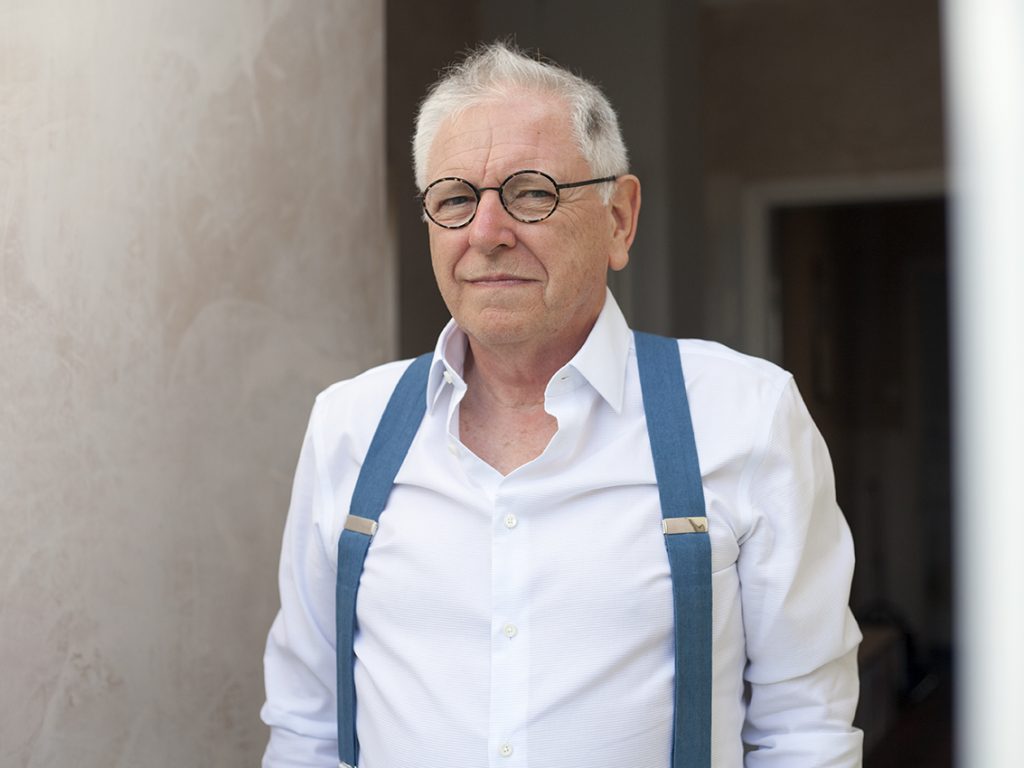

David Elliott is a cultural and art historian, writer, curator and museum director primarily concerned with modern and contemporary art. Elliott was Director of the Museum of Modern Art in Oxford, England from 1976-96, Director of Moderna Museet in Stockholm, Sweden from 1996-2001, the founding Director of the Mori Art Museum in Tokyo, Japan from 2001-06, the first Director of Istanbul Modern, Turkey in 2007 and from 2016-2019, Vice-Director and Senior Curator of the Redtory Museum of Contemporary Art in Guangzhou. From 1998-2004, he was President of CIMAM (the International Committee of ICOM for Museums and Collections of Modern Art) and in 2008, the Rudolf Arnheim Guest Professor of Art History at Humboldt University, Berlin; from 2012 to 2017 he was a guest professor in curatorship at the Chinese University, Hong Kong. Since 2010. He has been the Artistic Director of biennales of contemporary art in Sydney, Kiev, Moscow and Belgrade and is currently working freelance as a writer and curator.
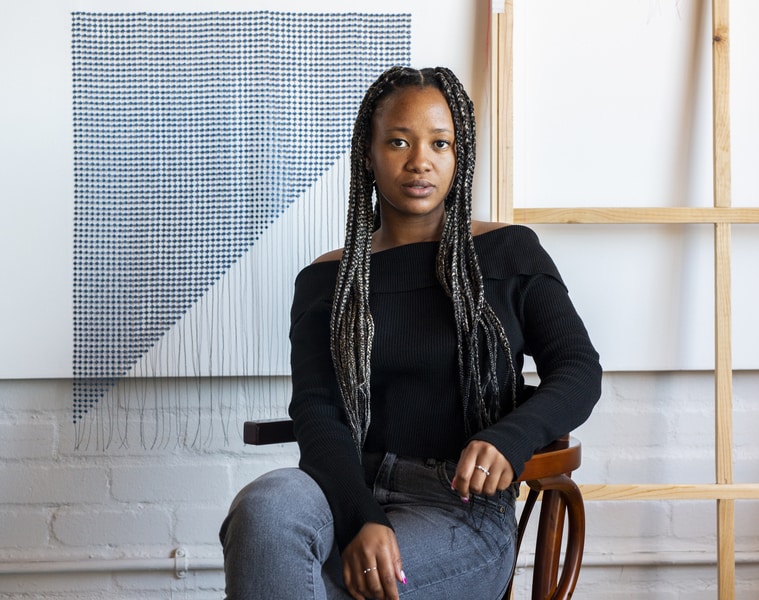

Bonolo Kavula was born in 1992 in Kimberley, South Africa, and currently lives and works in Cape Town, South Africa. She obtained a BA(FA) from the Michaelis School of Fine Art at the University of Cape Town in 2014, majoring in Printmaking. Kavula received the 2014 Katrine Harries Print Cabinet Award at the University of Cape Town and she was a founding member of the Cape Town based artist collective, Iqhiya. In 2021 Kavula won the Norval Sovereign African Art Prize.
In 2022 Kavula will present her first museum exhibition at the Norval Foundation, in Cape Town, South Africa. In 2021, she presented a solo booth at Art Basel Miami Beach, titled a re kopane ko thabeng, as well as her first solo exhibition, sewedi sewedi, at SMAC Gallery in Cape Town. Other recent projects include a solo booth at the 2020 Investec Cape Town Art Fair, as part of the curated section, TOMORROWS/TODAY, in Cape Town; Art Times, a performance at A4 Arts Foundation in Cape Town, in 2019; and Twenty Sexy, a performance at blank projects gallery in Cape Town in 2018.
Selected group exhibitions include: Inner Landscapes, at Bloom Galerie in Geneva, Switzerland; and Subverted Realities at Bode Projects in Berlin, Germany, both in 2022; Speculative Enquiry #1: On Abstraction, at the Michaelis Galleries in Cape Town (2019); The Main Complaint, curated by Michaela Limberis at the Zeitz Museum of Contemporary Art Africa (MOCAA); and Shady Tactics, curated by Thuli Gamedze at SMAC Gallery in Cape Town, both in 2018; Atomic Peace at The Bag Factory in Johannesburg, South Africa (2017); iQhiya Group Exhibition at the Association for Visual Arts (AVA) Gallery in Cape Town and New Monuments at Commune1 in Cape Town, both in 2016.
Her works are included in collections such as Pérez Art Museum Miami (PAMM) Collection in Miami, USA, and the Iziko South African National Gallery Collection in Cape Town, South Africa.
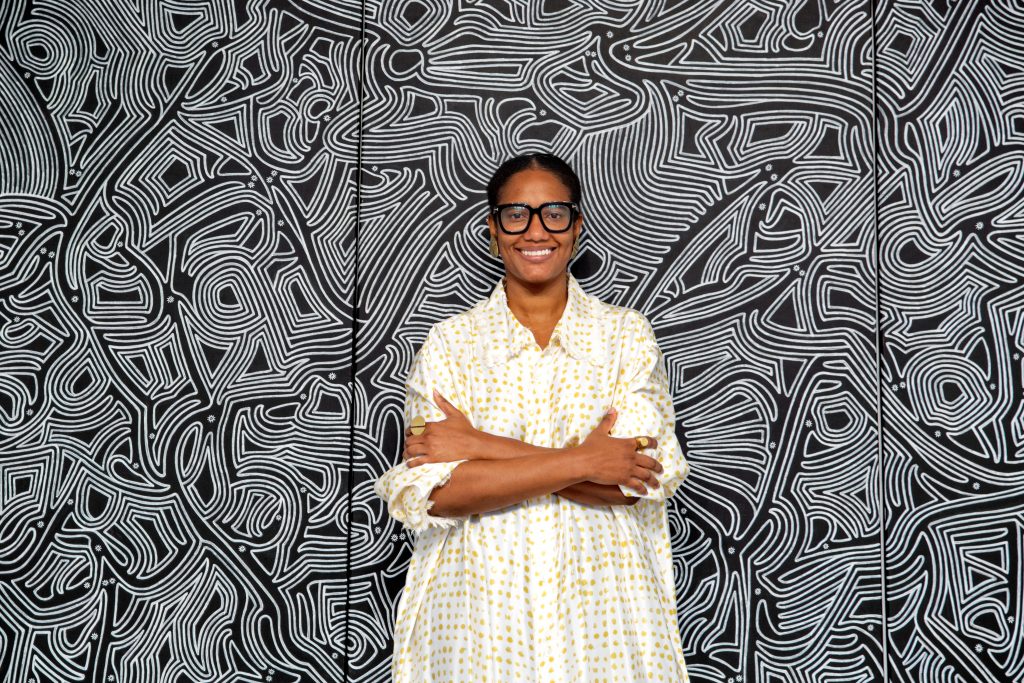

A native of France and Cameroon, Janine Gaëlle Dieudji is an independent exhibitions maker and producer living between Florence and Marrakech where she served as Director of Exhibitions at the Museum of African Contemporary Art Al Maaden (MACAAL) for four years.
Past and current experiences include exhibitions and projects in collaboration with institutions such as Le Murate Art District, American Academy in Rome, Villa Romana, Gallerie degli Uffizi as Co-director and Vice-president of the association BHMF (Black History Month Florence), as well as Co-founder of The Recovery Plan cultural center in Florence, Italy.
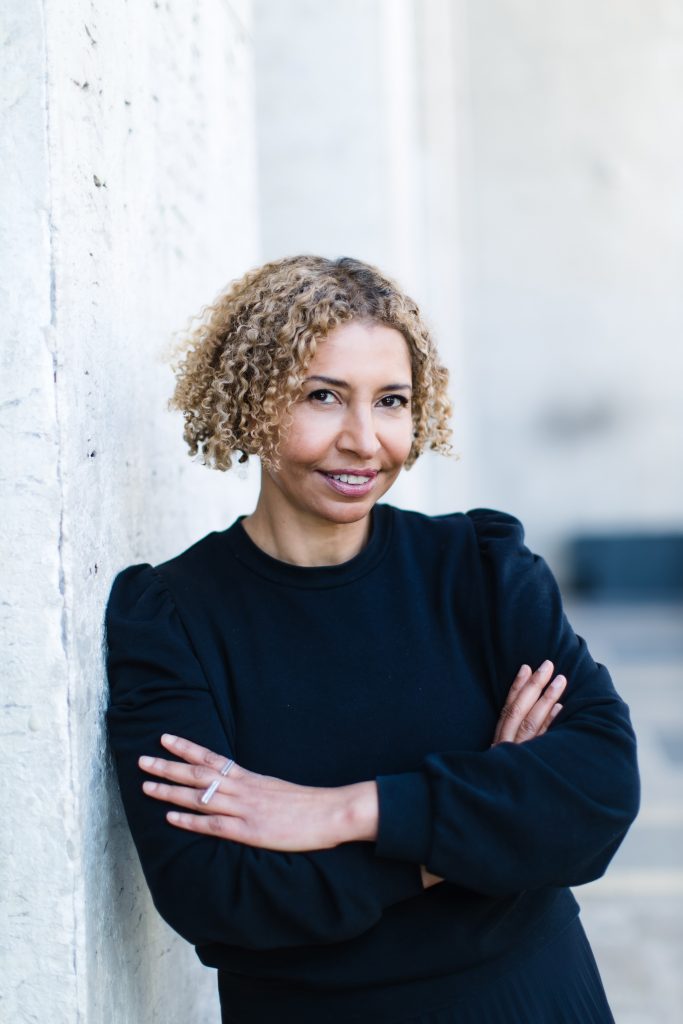

Marie-Ann Yemsi is an independent curator and contemporary art consultant. A graduate in political science, she is the founder and director of Agent Créatif(s), a Paris-based agency, which has developed a renowned expertise in cultural production and art consulting with a focus on contemporary artists from Africa, its diasporas and the Caribbean. Artistic Director of the 11th edition of the Rencontres de Bamako – African Biennale of Photography in 2017, she has been the curator of numerous international exhibitions for public or private institutions, in France and abroad.
Marie-Ann Yemsi is a member of the board of directors of the Palais de Tokyo in Paris and of the acquisitions commission of the Cnap – Centre National des Arts Plastiques, a public institution under the French Ministry of Culture dedicated to expand and manage France’s national contemporary art collection.
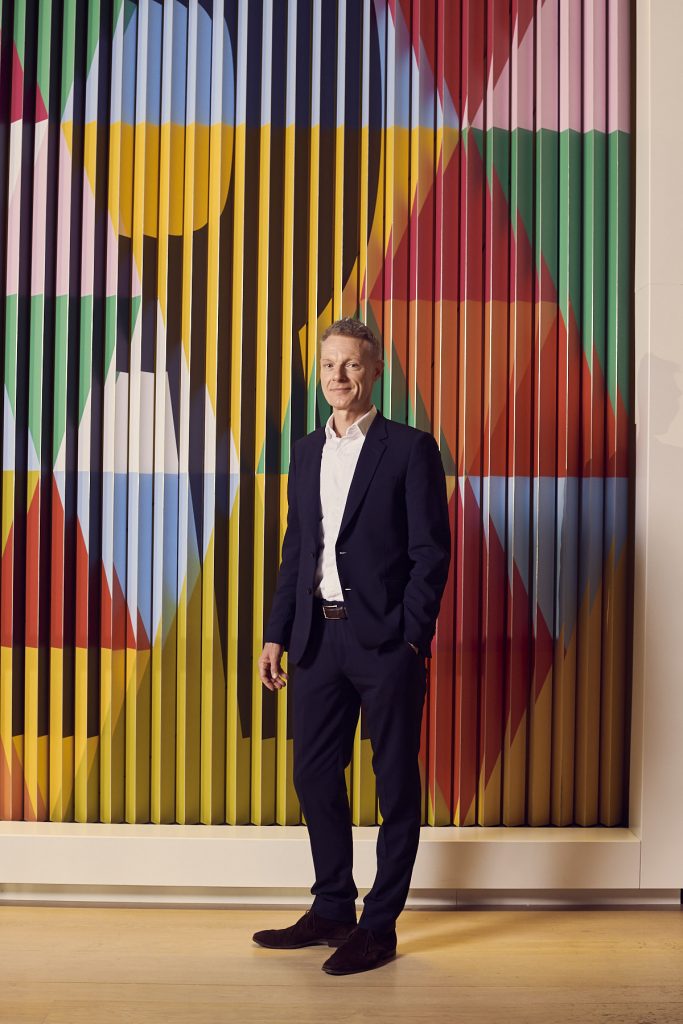

Tim Marlow is Chief Executive and Director of the Design Museum in London.
Formerly Artistic Director of the Royal Academy of Arts and Director of Exhibitions at White Cube, Marlow has been involved in the contemporary art world for the past thirty years as a curator, writer and broadcaster. He has worked with many of the most important and influential artists of our time to deliver wide-ranging and popular programmes and brings a commitment to diverse and engaging exhibitions to his new role showcasing the transformational capability of design.
Marlow sits on the Board of Trustees for the Imperial War Museum, Art on the Underground Advisory Board and Cultureshock Media. Marlow was awarded an OBE in 2019.
